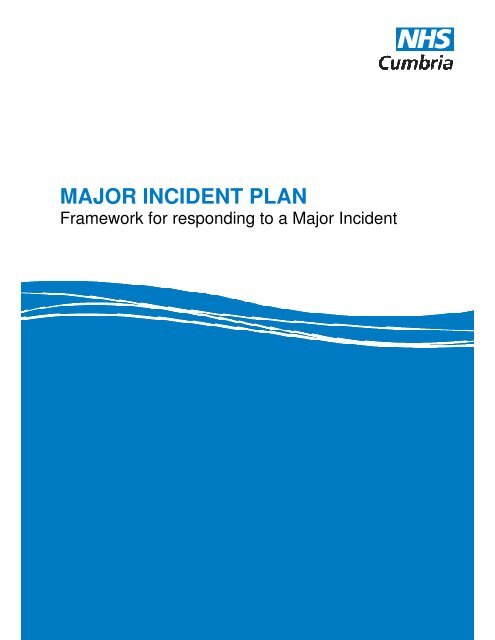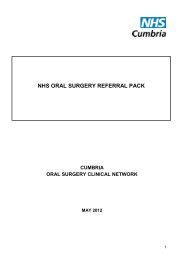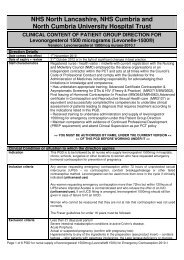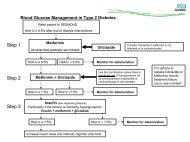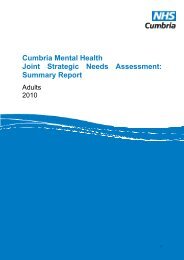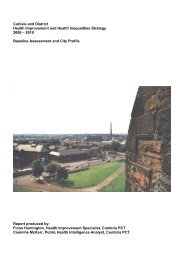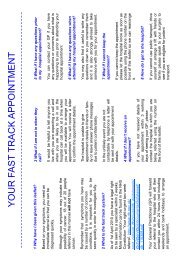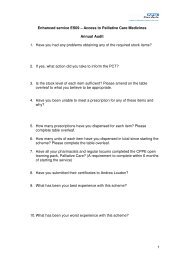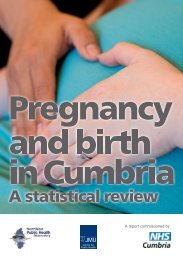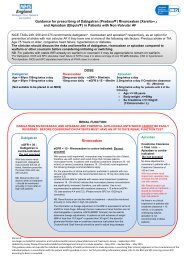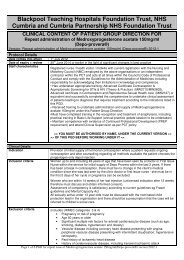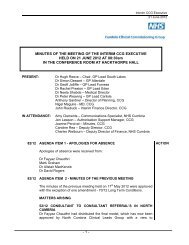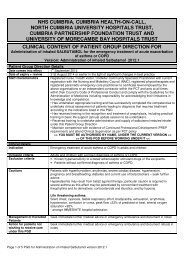MAJOR INCIDENT PLAN - NHS Cumbria
MAJOR INCIDENT PLAN - NHS Cumbria
MAJOR INCIDENT PLAN - NHS Cumbria
You also want an ePaper? Increase the reach of your titles
YUMPU automatically turns print PDFs into web optimized ePapers that Google loves.
<strong>MAJOR</strong> <strong>INCIDENT</strong> <strong>PLAN</strong>Framework for responding to a Major Incident<strong>NHS</strong> CUMBRIA<strong>MAJOR</strong> <strong>INCIDENT</strong> <strong>PLAN</strong> – FRAMEWORK FOR RESPONDING TO A <strong>MAJOR</strong> <strong>INCIDENT</strong>PAGE 1 OF 49Version 3 (Dec 2008)
Forward from the Director of Public HealthThis document is the Major Incident Plan for <strong>Cumbria</strong> Teaching Primary Care Trust (<strong>NHS</strong><strong>Cumbria</strong>). It outlines the strategic and operational arrangements to be undertaken by theTrust in the event of an ‘Unusual Incident’ or Major Incident/Civil Emergency. It has beenprepared in accordance with the Civil Contingencies Act 2004 and The <strong>NHS</strong> EmergencyPlanning Guidance 2005 and associated documents, and through consultation and closeliaison with many other relevant organisations. This ensures an integrated and coordinatedresponse to emergency preparedness.This document should be read in conjunction with the following <strong>NHS</strong> <strong>Cumbria</strong> Plans andsupporting documents:∼ Major Incident Plan– On Call Pack (Restricted Document),∼ National Heatwave Plan,∼ <strong>NHS</strong> <strong>Cumbria</strong> Pandemic Influenza Plan,∼ <strong>NHS</strong> <strong>Cumbria</strong> Business Continuity PlanThe <strong>NHS</strong> <strong>Cumbria</strong> Trust Board will receive regular update reports, at least annually, includingreports on exercises, training and testing undertaken by <strong>NHS</strong> <strong>Cumbria</strong>. All staff mustfamiliarise themselves with the contents of the Plan, not only to monitor their individual areasof responsibility as preparation for their response to an incident, also to feedback usefulinformation and suggest improvements to the <strong>NHS</strong> <strong>Cumbria</strong> Emergency PlanningManagement Group.All comments and feedback to be forwarded to the Emergency Planning Manager.This is update Version 3 of the Major Incident Plan:Implementation Date: 1 st December 2008Latest Review Date: 1 st November 20010Signature Date 21 st January 2009Professor John R Ashton, CBEDirector of Public HealthCounty Medical Officer<strong>NHS</strong> CUMBRIA<strong>MAJOR</strong> <strong>INCIDENT</strong> <strong>PLAN</strong> – FRAMEWORK FOR RESPONDING TO A <strong>MAJOR</strong> <strong>INCIDENT</strong>Version 3 (Dec 2008)
Document ControlPolicy Number:Author/ContactCPCT/004/015AEmergency Planning ManagerDiane WeatherleyTel: 01539 797835Email: Diane.Weatherley@cumbriapct.nhs.ukVersion 03StatusApprovedIssue Date 1 st December 2008Review Date 1 st November 2010Date Equality and 6 th November 2008Diversity ImpactAssessment completeDistributionAvailable on <strong>NHS</strong> <strong>Cumbria</strong> Internet;www.cumbriapct.nhs.ukPlease note that the Internet version of this document is theonly version that is maintained. Any printed copies shouldtherefore be viewed as ‘uncontrolled’ and as such, may notnecessarily contain the latest updates and amendmentsVersion Date Comment1 st Draft 7/2/07Circulated for comment within PCT andkey partner agencies2 nd Draft 27/2/07Circulated for final comment toDirectors, SHA and key partnerFinal Draft 9/3/07Submitted for PCT Board approvalAgreement by Board 21/3/07Board Approval, with minoramendmentsAmendment 1 27/09/07Updates of Plan approved by BoardVersion 2 07/12/07Updated Plan circulated tostakeholders30/09/08Vs 3 Plan circulated to stakeholders forcommentVersion 36/11/08Standards & Quality Committee27/11/08Trust Board<strong>NHS</strong> CUMBRIA<strong>MAJOR</strong> <strong>INCIDENT</strong> <strong>PLAN</strong> – FRAMEWORK FOR RESPONDING TO A <strong>MAJOR</strong> <strong>INCIDENT</strong>PAGE 1 OF 49Version 3 (Dec 2008)
LIST OF REGISTERED HOLDERSCOPIES OF THIS <strong>PLAN</strong> AND ANY FUTURE UPDATES WILL BE SENT TO THE FOLLOWING REGISTEREDHOLDERS:Plan No. OrganisationInternal Distribution (Copy sent)008 Director of Public Health009 Chief Executive (Gold on Call)010 Chairman011 Chair of the Professional Executive Committee (Gold on Call)012 Director of Market Development013 Director of Resources014 Director of Corporate Affairs015 Director of Clinical Services016 Communications Manager020Interim Lead Organisational Development/Primary Care Lead (Gold onCall)001Interim Lead Mental Health Commissioning and Public Engagement(Gold on Call)021 Interim Lead Human Resources Lead (Gold on Call)019 Interim Board Governance Lead (Gold on Call)002 Associate Director of Health Protection024 Associate Director of Nursing (Gold on Call)025 Medical Director (Gold on Call)026 Associate Director, Mental Health Commissioning (Gold on Call)017 Associate Director, Primary Care (Gold on Call)018 Assistant Chief Executive (Gold on Call)002 Associate Director of Health Protection (Public Health on Call)NUMBERED COPIES HAVE ALSO BEEN GIVEN TO STAFF ON THE FOLLOWING ROTAS:<strong>Cumbria</strong> and Lancashire Public Health on CallPCT Silver on CallExternal Distribution<strong>Cumbria</strong> Partnership <strong>NHS</strong> Foundation TrustNorth West Ambulance Service TrustUniversity Hospitals of Morecambe <strong>NHS</strong> TrustNorth <strong>Cumbria</strong> University Hospitals <strong>NHS</strong> Trust<strong>Cumbria</strong> & Lancashire Health Protection Unit<strong>NHS</strong> North West (SHA)<strong>Cumbria</strong> Resilience Forum Secretariat<strong>Cumbria</strong> County Council Emergency Planning UnitOut of Hours Service CuedocOut of Hours Service BaycallUnited Utilities<strong>NHS</strong> CUMBRIA<strong>MAJOR</strong> <strong>INCIDENT</strong> <strong>PLAN</strong> – FRAMEWORK FOR RESPONDING TO A <strong>MAJOR</strong> <strong>INCIDENT</strong>PAGE 2 OF 46Version 3 (Dec 2008)
It will be the responsibility of the Registered Holder to ensure that they are using the latestversion of the plan. Please could Registered Holders remove copies of supersededdocuments and replace them with the revised versions. All superseded versions should bedestroyed. If a registered plan holder changes position or leaves their organisation they arerequested to notify the Director of Public Health <strong>NHS</strong> <strong>Cumbria</strong> using the following form:CHANGE OF REGISTERED <strong>PLAN</strong> HOLDERPlease change the Register of Plan Holders:Plan NumberFromJob TitlePlace of WorkTel. No.E-mailToJob TitlePlace of WorkTel. No.E-mailSignedDatePrint NamePosition HeldPlease return to:Emergency Planning Manager<strong>NHS</strong> <strong>Cumbria</strong>Trust HQPenrith HospitalBridge Lane, Penrith CA11 8HXDiane.Weatherley@cumbriapct.nhs.ukPlease photocopy this form when submitting requests for amendments – this formshould remain in the Plan for future duplication<strong>NHS</strong> CUMBRIA<strong>MAJOR</strong> <strong>INCIDENT</strong> <strong>PLAN</strong> – FRAMEWORK FOR RESPONDING TO A <strong>MAJOR</strong> <strong>INCIDENT</strong>PAGE 3 OF 46Version 3 (Dec 2008)
PAGE LEFT INTENTIONALLY BLANK<strong>NHS</strong> CUMBRIA<strong>MAJOR</strong> <strong>INCIDENT</strong> <strong>PLAN</strong> – FRAMEWORK FOR RESPONDING TO A <strong>MAJOR</strong> <strong>INCIDENT</strong>PAGE 4 OF 46Version 3 (Dec 2008)
TABLE OF CONTENTSChapter Para Description PageNoDocument Control 1List of Registered Holders 2Change of Registered Plan Holder 3Table of Contents 5SECTION 1 INTRODUCTION1 Introduction 92 Context of the Plan 93 Implementation 103.3 Training 10SECTION 2 FRAMEWORK, GUIDANCE AND DEFINITIONS4 Civil Contingencies Act 2004 114.1 Overview 114.3 Responders 114.4 Civil Protection Duties 114.5 Duty on Category 1 Responders 124.6 Definition of an Emergency 124.8 Local Resilience Forum 124.10 Integrated Emergency Management 134.11 Community Risk Register 134.15 Risks Internal to the PCT 144.16 Risks External to the PCT 144.17 Further Information 155 <strong>NHS</strong> Emergency Planning Guidance 2005 155.1 Overview 155.2 <strong>NHS</strong> Definition of a Major Incident 155.7 Mass Casualty Incident 165.8 The Levels of a Major Incident in the <strong>NHS</strong> 165.10 Forms of a Major Incident 175.11 Unusual Incident 17SECTION 3 CORPORATE RESPONSIBILITIES6 The Responsibility of the Chief Executive 186.1 On behalf of <strong>NHS</strong> North West 186.2 <strong>NHS</strong> <strong>Cumbria</strong> Teaching PCT 197 <strong>NHS</strong> <strong>Cumbria</strong> Teaching PCT Responsibilities 207.1 Planning responsibilities of <strong>NHS</strong> <strong>Cumbria</strong> Teaching PCT 207.2 The Role of Primary and Community Health Services 208 The Roles and Responsibilities of <strong>NHS</strong> Trusts in <strong>Cumbria</strong> 218.1 North <strong>Cumbria</strong> University Hospitals <strong>NHS</strong> Trust21University Hospitals of Morecambe Bay <strong>NHS</strong> Trust<strong>Cumbria</strong> Partnership <strong>NHS</strong> Foundation Trust8.4 <strong>Cumbria</strong> & Lancashire Health Protection Unit 218.5 North West Ambulance Service 228.6 <strong>NHS</strong> North West (Strategic Health Authority) 228.9 <strong>NHS</strong> Direct 23<strong>NHS</strong> CUMBRIA<strong>MAJOR</strong> <strong>INCIDENT</strong> <strong>PLAN</strong> – FRAMEWORK FOR RESPONDING TO A <strong>MAJOR</strong> <strong>INCIDENT</strong>PAGE 5 OF 46Version 3 (Dec 2008)
SECTION 4 ALERT AND ACTIVATION9 Alerting <strong>NHS</strong> <strong>Cumbria</strong> Teaching PCT 249.3 Unusual Incident 249.5 Contacting Public Health 2410 Declaration of a Major Incident 2411 Criteria for Activation of the Plan 2512 12.1 <strong>NHS</strong> Alert Messages 2512.2 <strong>NHS</strong> Alert Format 2613 Alert and Response Flowchart for <strong>Cumbria</strong> PCT 2714 Notification of <strong>NHS</strong> Gold Commander 2815 Levels of Major Incident 2915.1 Incident Affecting single <strong>NHS</strong> Trust (Level 1) 2915.3 Serious Untoward Incidents 2915.5 Incident where the PCT may need to declare a Major Incident 3016 Incident affecting the Wider <strong>NHS</strong> in <strong>Cumbria</strong> (Level II) 3117 Multi Agency Major Incidents (Level III) 3218 Notification of <strong>NHS</strong> Organisations 3218.2 <strong>NHS</strong> North West (Strategic Health Authority) 3318.3 <strong>Cumbria</strong> and Lancashire Health Protection Unit 3318.4 <strong>Cumbria</strong> Out of Hours Services 3318.6 North <strong>Cumbria</strong> University Hospitals <strong>NHS</strong> Trust33University Hospitals Morecambe Bay <strong>NHS</strong> Trust18.7 <strong>Cumbria</strong> Partnership <strong>NHS</strong> Foundation Trust 3318.8 <strong>NHS</strong> Direct 3419 Recovery Working Group 3420 Procedure for Stand Down of a Major Incident 3421 Debrief 35SECTION 5 MANAGEMENT OF THE <strong>INCIDENT</strong>22 Overview 3623 Strategic Level (Gold) 3624 Regional Civil Contingencies Committee 3625 Scientific and Technical Advice Cell 3726 Tactical Level (Silver) 3727 Operational Level (Bronze) 37SECTION 6 ESTABLISHING A <strong>MAJOR</strong> <strong>INCIDENT</strong> TEAM28 <strong>NHS</strong> Gold Commander 3829 <strong>NHS</strong> <strong>Cumbria</strong> Incident Control Team 3830 Establishment of <strong>NHS</strong> <strong>Cumbria</strong> Incident Control Room 4031 Helplines 4132 Telephone Numbers/Access Information 4133 Record Keeping 4133.1 Preservation of Documents 4133.2 Definition of ‘Documents’ 4133.3 Incident Log 4233.5 Incident Recording 4234 Communications and the Media34.1 Overview 4234.2 Procedure during a Major Incident 4234.3 News Releases and Statements 43<strong>NHS</strong> CUMBRIA<strong>MAJOR</strong> <strong>INCIDENT</strong> <strong>PLAN</strong> – FRAMEWORK FOR RESPONDING TO A <strong>MAJOR</strong> <strong>INCIDENT</strong>PAGE 6 OF 46Version 3 (Dec 2008)
SECTION 7 GENERAL GUIDANCE ON <strong>INCIDENT</strong> RESPONSE35 4435.1 Casualty Enquiries 4435.2 Health and Safety 4435.3 Social Services 4435.4 Voluntary Services 4435.5 Bank Staff 4435.6 Minimising Requirements for Emergency Admissions 4435.7 Accelerating Hospital Discharges 4535.10 Mass Vaccinations 4535.11 Mass Fatalities 4535.13 Follow up arrangements for affected patients in the aftermath 46of a Major Incident35.15 Mobilisation of extra equipment 4635.16 Useful Weblinks 46<strong>NHS</strong> CUMBRIA<strong>MAJOR</strong> <strong>INCIDENT</strong> <strong>PLAN</strong> – FRAMEWORK FOR RESPONDING TO A <strong>MAJOR</strong> <strong>INCIDENT</strong>PAGE 7 OF 46Version 3 (Dec 2008)
PAGE LEFT INTENTIONALLY BLANK<strong>NHS</strong> CUMBRIA<strong>MAJOR</strong> <strong>INCIDENT</strong> <strong>PLAN</strong> – FRAMEWORK FOR RESPONDING TO A <strong>MAJOR</strong> <strong>INCIDENT</strong>PAGE 8 OF 46Version 3 (Dec 2008)
SECTION 11. INTRODUCTION1.1 The Major Incident Plan, of which this document forms part, provides the frameworkthat defines how the <strong>NHS</strong> <strong>Cumbria</strong> Teaching PCT will respond to a Major Incident, both as aprovider of <strong>NHS</strong> primary care services and as a Category 1 Responder under the CivilContingencies Act (CCA) and <strong>NHS</strong> Emergency Guidance 2005, and associated documents1.2 <strong>NHS</strong> <strong>Cumbria</strong> Teaching PCT will achieve this aim through a response derived from:• Effective management of the incident together with coordination and monitoring of theincident from a Health Services perspective.• Effective communications through situation reporting mechanisms from and with HealthServices and other partner agencies.• Effective arrangements for the coordination and delivery of <strong>NHS</strong> resources in the courseof an incident• Effective staff training and preparedness on their Major Incident response.2. CONTEXT OF THE <strong>MAJOR</strong> <strong>INCIDENT</strong> <strong>PLAN</strong>2.1 In preparation of the Plan due recognition has been taken of the requirements underthe following documentation:• The Civil Contingencies Act 2004• The <strong>NHS</strong> Emergency Planning Guidance 2005• Public Health Core Standard C24• Department of Health document “Beyond a Major Incident”• <strong>Cumbria</strong> Resilience Forum policies.2.2 The Plan should be viewed in the context of the various National, Regional and Localplans that have been developed to respond to the wide range of potential major incidents.The Plan is generic and outlines how <strong>Cumbria</strong> PCT will respond to an emergency event. Asthese vary in nature and are unpredictable, the Plan provides a core set of principles andprocesses that can be applied to handle a range of circumstances.The objectives of this Plan are to:• Meet the requirements of the Civil Contingencies Act 2004• Provide a rapid response to any major incident affecting the local community and asrequested by neighbouring Trusts• Provide a rapid response to any major incident that threatens the health services, and• Provide for a rapid response to any major incident, which threatens the businesscontinuity of Primary Care Trust services2.4 In some cases <strong>NHS</strong> <strong>Cumbria</strong> may use this Major Incident Plan to deal with a situationto respond to internal events. However in many situations <strong>NHS</strong> <strong>Cumbria</strong> would be activating<strong>NHS</strong> CUMBRIA<strong>MAJOR</strong> <strong>INCIDENT</strong> <strong>PLAN</strong> – FRAMEWORK FOR RESPONDING TO A <strong>MAJOR</strong> <strong>INCIDENT</strong>PAGE 9 OF 46Version 3 (Dec 2008)
the plan within an Integrated Emergency Management Response with partner agencies (seepara. 4.10).2.5 <strong>NHS</strong> <strong>Cumbria</strong> major incident response arrangements are linked with the command andcontrol arrangements of the <strong>NHS</strong> North West Strategic Health Authority, the County StrategicCoordination Group (Gold Command, normally chaired by Police), and the Regional CivilContingencies Committee.2.6 Agencies consulted in the preparation of this plan include:• <strong>NHS</strong> North West,• <strong>Cumbria</strong> Police,• <strong>Cumbria</strong> Fire and Rescue Service• North West Ambulance Service,• <strong>Cumbria</strong> and Lancashire Health Protection Unit,• Local Authorities in <strong>Cumbria</strong> (including the County Council Emergency Planning Unit)• Acute Hospital Trusts relating to <strong>NHS</strong> <strong>Cumbria</strong>,• <strong>Cumbria</strong> Mental Health and Learning Disability <strong>NHS</strong> Foundation Partnership Trust.3 IMPLEMENTATION3.1 Following approval by the <strong>NHS</strong> <strong>Cumbria</strong> Trust Board this Plan and subsequentupdates will be distributed to all those listed on the Registered Plan Holders list. Part A willalso be available on the <strong>NHS</strong> <strong>Cumbria</strong> Internet and Intranet Websites.3.2 The Trust Board will receive a minimum twice yearly Board Report on <strong>NHS</strong> <strong>Cumbria</strong>Emergency Preparedness. The Plan will be reviewed, at least annually, and after everyincident of activation.TRAINING3.3 Regular training and exercise events are held in <strong>Cumbria</strong>, facilitated by <strong>Cumbria</strong>County Council Emergency Planning Unit. Members who have volunteered to support <strong>NHS</strong><strong>Cumbria</strong> incident response will be invited to attend these events. Regular training will beprovided for all Gold and Silver on call staff, to include:• Communications test every 6 months• Tabletop exercise every year• Live exercise every 3 years –this may take the form of multi agency• a segment on emergency preparedness for all new staff, as part of the mandatorytraining workbook ‘A Risk to Far’<strong>NHS</strong> CUMBRIA<strong>MAJOR</strong> <strong>INCIDENT</strong> <strong>PLAN</strong> – FRAMEWORK FOR RESPONDING TO A <strong>MAJOR</strong> <strong>INCIDENT</strong>PAGE 10 OF 46Version 3 (Dec 2008)
SECTION 2 FRAMEWORK, GUIDANCE AND DEFINITIONS4 CIVIL CONTINGENCIES ACT 2004OVERVIEW4.1 The Civil Contingencies Act (2004) and accompanying regulations and guidanceprovides a single framework for civil protection across the United Kingdom. The Act (CCA) isdivided into two parts:Part 1 - focuses on local arrangements for civil protection, establishing a statutoryframework of roles and responsibilities for local respondersPart 2 – focuses on emergency powers, establishing a modern framework for the use ofspecial legislative measures that might be necessary to deal with the effects of the mostserious emergencies.4.2 <strong>NHS</strong> <strong>Cumbria</strong> and <strong>NHS</strong> North West Strategic Health Authority have an agreement that<strong>NHS</strong> <strong>Cumbria</strong> should act on behalf of the Strategic Health Authority in planning and leadingthe <strong>NHS</strong> emergency response. This places additional responsibilities on <strong>NHS</strong> <strong>Cumbria</strong> whichare reflected in this plan.RESPONDERS4.3 Two types of responders have been identified, these are:Category 1 Responders are those organisations at the core of any emergencyresponse; for example local authorities, the emergency services, Primary Care Trusts,<strong>NHS</strong> Trusts and <strong>NHS</strong> Foundation Trusts with accident/emergency facilities, AmbulanceService <strong>NHS</strong> Trusts, and the Health Protection Agency.Category 2 Responders are those organisations likely to be heavily involved in anyemergency response, for example utility companies (water, gas, electricity,telecommunications), rail companies, airport operators, the Highways Agency, StrategicHealth Authorities.CIVIL PROTECTION DUTIES4.4 <strong>NHS</strong> <strong>Cumbria</strong> is now a Category 1 Responders under the Act (CCA). As a Category 1responder, the Trust is now subject to the full set of civil protection duties and we are requiredto:• Assess the risks of emergencies occurring and use this to inform contingency planning;• Put in place emergency plans• Put into place Business Continuity Management arrangements to enable <strong>NHS</strong> <strong>Cumbria</strong>to deliver those functions which may be required in an emergency• Put into place arrangements to make information available to the public about civilprotection matters and maintain arrangements to warn, inform and advise the public inthe event of an emergency.<strong>NHS</strong> CUMBRIA<strong>MAJOR</strong> <strong>INCIDENT</strong> <strong>PLAN</strong> – FRAMEWORK FOR RESPONDING TO A <strong>MAJOR</strong> <strong>INCIDENT</strong>PAGE 11 OF 46Version 3 (Dec 2008)
• Share information with other local responders to enhance coordination; and• Co-operate with other local responders to enhance coordination and efficiency.DUTY ON CATEGORY 1 RESPONDERS4.5 As a Category 1 Responder, <strong>NHS</strong> <strong>Cumbria</strong> (Teaching Primary Care Trust) mustperform its duties under the Act (CCA) only in relation to two situations, either of which posesa considerable test for a Category 1 Responders ability to perform its normal functions. Thetwo tests are:a. Where the emergency would be likely to seriously obstruct its ability to perform itsfunctionsb. Where the Category 1 Responder:- Would consider it necessary or desirable to act to prevent, reduce, control ormitigate the emergency’s effects or otherwise take action, and- Would be unable to act without changing the deployment of its resources oracquiring additional resourcesDEFINITION OF AN EMERGENCY4.6 Part 1 of the Act (CCA) defines an emergency as:“An event or situation which threatens serious damage to human welfare in a place in theUnited Kingdom, the environment of a place in the United Kingdom, or war or terrorism whichthreatens serious damage to the security of the United Kingdom”4.7 The definition is concerned with the consequences, rather than cause or source.Therefore an emergency inside or outside the United Kingdom is covered by the definitionprovided it has consequences inside the United KingdomLOCAL RESILIENCE FORUM (LRF)4.8 The Act (CCA) places a duty on Category 1 and Category 2 responders to cooperatelocally to improve emergency preparedness and response. The principal mechanism for multiagency cooperation is the development of Local Resilience Forums, based on police area.<strong>Cumbria</strong> Resilience Forum (CRF) operates locally to fulfil this duty.4.9 All <strong>NHS</strong> Trusts in <strong>Cumbria</strong> are members of the <strong>Cumbria</strong> Resilience Forum. Howeverto better coordinate the <strong>NHS</strong> planning and response for emergencies <strong>NHS</strong> <strong>Cumbria</strong> TeachingPrimary Care Trust is the Lead Trust for the county and attends on behalf of UniversityHospitals Morecambe Bay <strong>NHS</strong> Trust and North <strong>Cumbria</strong> University Hospitals <strong>NHS</strong> Trust and<strong>Cumbria</strong> Partnership <strong>NHS</strong> Foundation Trust. North West Ambulance Service attends theCRF in its own right.INTEGRATED EMERGENCY MANAGEMENT4.10 Civil protection arrangements need to be integrated both within and between Category1 and 2 responders. In line with national guidance, <strong>Cumbria</strong> Resilience Forum has developedan integrated approach to emergency preparedness and response to enable responders in<strong>NHS</strong> CUMBRIA<strong>MAJOR</strong> <strong>INCIDENT</strong> <strong>PLAN</strong> – FRAMEWORK FOR RESPONDING TO A <strong>MAJOR</strong> <strong>INCIDENT</strong>PAGE 12 OF 46Version 3 (Dec 2008)
<strong>Cumbria</strong> to discharge their civil protection duties. The following six activities are fundamentalto an Integrated Emergency Management (IEM) approach:a. Anticipation; sometimes called horizon scanning. Responders should aim to beaware of new hazards and threats which might affect their locality, and be ready torevise their risk assessments and plans accordingly;b. Assessment; of the risks that may result from the hazards identified;c. Prevention; this is an important component of Integrated Emergency Management.The Act (CCA) does not deal with it to any extent because it is largely dealt with byother legislation, for example fire safety, building regulations etc. Prevention underthe Act (CCA) is limited to actions that help prevent an emergency which may beabout to occur. For example, activating an emergency plan in advance of a majorpublic event;d. Preparation; although the Act (CCA) focuses on preparedness for response toemergencies, it should be seen in the wider context of safety, risk and threatmanagement. Although the Act (CCA) concentrates on the maintenance of planningarrangements, effective management is the aim. Planning is a process of preparingmanagers and personnel for the act of managing an emergencye. Responsef. Recovery;COMMUNITY RISK REGISTER4.11 The Act (CCA) places a duty on Category 1 Responders to cooperate with each otherin maintaining a Community Risk Register (CRR). The CRR provides an agreed position onthe risk affecting <strong>Cumbria</strong> and on the planning and resource priorities required to prepare forthose risks. The purpose of the CRR is to ensure that all Category 1 Responders have anaccurate and shared understanding of the risks they face so that planning may beproportionate.4.12 The purpose of the Community Risk Register is to enable each Category 1 Responderto:a. Be fully informed of the risk of an emergency in its area;b. Benefit from the range of views on risk of its partners on the LRF;c. Identify collectively the main local emergency plans and capabilities which may beneeded across all Category 1 responders;d. Decide on which plans and capabilities should properly fall to the it, ande. Know which of its partners in the LRF acknowledges responsibility for developingplans and capabilities against the various risksThe <strong>Cumbria</strong> Community Risk Register is available online at <strong>Cumbria</strong> Resilience Website:http://www.cumbriaresilience.info/home.asp<strong>NHS</strong> CUMBRIA<strong>MAJOR</strong> <strong>INCIDENT</strong> <strong>PLAN</strong> – FRAMEWORK FOR RESPONDING TO A <strong>MAJOR</strong> <strong>INCIDENT</strong>PAGE 13 OF 46Version 3 (Dec 2008)
4.13 In order to plan for a Major Incident local hazards are assessed that will impact on thecommunity. The results of the Risk Assessment process are recorded in the Community RiskRegister maintained by the <strong>Cumbria</strong> Local Resilience Forum. Through involvement withvarious subgroups of <strong>Cumbria</strong> Resilience Forum, <strong>NHS</strong> Trusts in <strong>Cumbria</strong> contribute to theCommunity Risk Register.4.14 The broad headings that detail the hazards which could impact on <strong>NHS</strong> <strong>Cumbria</strong> arelisted in the following section. Each of these generates potential internal risk which is dealtwith under the business continuity arrangements, and includes the following areas.RISKS INTERNAL TO <strong>NHS</strong> CUMBRIA4.15 Disruption of normal work and interruption of core business can be caused by:• Loss of or lack of availability of key staff• Loss of key premises• Failure or overload of telephone or IT communication networks• A Major Incident which overwhelms the Health Service capacity to deal with it.RISKS EXTERNAL TO <strong>NHS</strong> CUMBRIA4.16 Further information on the risk assessment process can be found in <strong>NHS</strong> <strong>Cumbria</strong>Business Continuity Plan, which will soon be available for staff on the Intranet.• Industrial accidents and environmental pollution• Transport accidents• Severe weather• Structural failures• Human health• Animal health• Industrial technical failure• Terrorism – non infrastructure• Chemical, Biological, Radiological, Nuclear (CBRN) attack - infrastructure• Electronic attack – infrastructureFURTHER INFORMATION4.17 Further guidance and supporting documents can be found on the United KingdomResilience Website at: http://www.ukresilience.gov.uk/<strong>NHS</strong> CUMBRIA<strong>MAJOR</strong> <strong>INCIDENT</strong> <strong>PLAN</strong> – FRAMEWORK FOR RESPONDING TO A <strong>MAJOR</strong> <strong>INCIDENT</strong>PAGE 14 OF 46Version 3 (Dec 2008)
5. <strong>NHS</strong> EMERGENCY <strong>PLAN</strong>NING GUIDANCE (2005)OVERVIEW5.1 The <strong>NHS</strong> Emergency Planning Guidance (2005) was produced in response to the Act(CCA). The Guidance is a set of general principles to guide <strong>NHS</strong> organisations in developingtheir ability to:a. Respond to major incident(s), andb. Manage their recovery from a major incident(s)Whether the incident(s) has effects locally, regionally or nationally.<strong>NHS</strong> DEFINITION OF A <strong>MAJOR</strong> <strong>INCIDENT</strong>5.2 According to <strong>NHS</strong> Emergency Planning Guidance 2005 a major incident, as it wouldaffect the <strong>NHS</strong>, is defined as“any occurrence which representsa. a serious threat to the health of the communityb. disruption to the service, orc. causes (or is likely to cause) such numbers of types of casualties as to require specialarrangements to be implemented by hospitals, ambulance trusts or Primary CareTrusts”5.3 For the <strong>NHS</strong>, “Major Incident” is the term in general use. With the implementation ofthe Civil Contingencies Act 2004 the term “emergency” may be used by some respondersinstead of “incident”. However, the <strong>NHS</strong> will continue to use the term Major Incident so as toavoid confusion with other elements of the services it provides.5.4 A major incident is any event whose impact cannot be handled within routine servicearrangements. It requires the implementation of special procedures by one of the emergencyservices, the <strong>NHS</strong>, or a Local Authority to respond to it for:• The rescue and transportation of a large number of casualties;• The involvement directly or indirectly of large numbers of people;• The handling of a large number of enquiries likely to be generated both from the publicand the news media, usually to the police;• Any incident that requires the large scale combined resources of the emergencyservices;• The mobilisation and organisation of the emergency services and supportingorganisations5.5 Each individual <strong>NHS</strong> organisation must plan to handle incidents in which its ownfacilities, or neighbouring ones, may be overwhelmed. The organisation itself may be<strong>NHS</strong> CUMBRIA<strong>MAJOR</strong> <strong>INCIDENT</strong> <strong>PLAN</strong> – FRAMEWORK FOR RESPONDING TO A <strong>MAJOR</strong> <strong>INCIDENT</strong>PAGE 15 OF 46Version 3 (Dec 2008)
affected by its own internal major incident or by breakdown of utilities, major equipmentfailure, hospital acquired infections, violent crime or the need to deal with one contaminatedperson may paralyse the provision of services and jeopardise safety arrangements.5.6 Individual <strong>NHS</strong> organisations can self-declare a major incident when its own facilitiesand/or resources or those of its neighbours are overwhelmed. What is a major incident to the<strong>NHS</strong> may not be a major incident to other responding local agencies.MASS CASUALTY <strong>INCIDENT</strong>5.7 The <strong>NHS</strong> document “Beyond a Major Incident” sets out guidance and policy to assistthe <strong>NHS</strong> to plan for a major incident of very serious proportions involving potentially largenumbers of casualties. It defines a mass casualty incident as:‘A disastrous event or other circumstances, where the normal major incident responses of<strong>NHS</strong> organisations must be augmented by extraordinary measures, in order to cope.’Beyond a Major IncidentTHE LEVELS OF A <strong>MAJOR</strong> <strong>INCIDENT</strong> IN THE <strong>NHS</strong>5.8 <strong>NHS</strong> organisations are accustomed to normal fluctuations in daily demand for services.Whilst at times this may lead to facilities being fully stretched, such fluctuations are managedwithout activation of special measures by means of established management procedures andescalation policies. The levels of incident for which <strong>NHS</strong> organisations are required todevelop emergency preparedness arrangements are:Major (Level I) - individual ambulance trusts and acute trusts are well versed in handlingincidents such as multi-vehicle motorway crashes within the long established majorincident plans. More patients will be dealt with, probably faster and with fewer resources,than usual but it is possible to maintain the usual levels of service.Mass (Level II)- much larger-scale events affecting potentially hundreds rather than tensof people, possibly also involving the closure or evacuation of a major facility (for example,because of fire or contamination) or persistent disruption over many days. These willrequire a collective response byseveral or many neighbouring trusts.Catastrophic (Level III) - events of potentially catastrophic proportions that severelydisrupt health and social care and other functions (for example, mass casualties, power,water, etc) and that exceed even collective local capability within the <strong>NHS</strong>In addition, there are pre-planned major events that require planning, for example,demonstrations, sports fixtures, air shows, etc that may also require a response.<strong>NHS</strong> CUMBRIA<strong>MAJOR</strong> <strong>INCIDENT</strong> <strong>PLAN</strong> – FRAMEWORK FOR RESPONDING TO A <strong>MAJOR</strong> <strong>INCIDENT</strong>PAGE 16 OF 46Version 3 (Dec 2008)
5.9 Although not formally described there may be events occurring on a national scale, forexample fuel strikes, pandemic or multiple events that require the collective capability of the<strong>NHS</strong> nationally (<strong>NHS</strong> Guidance 2005)FORMS OF A <strong>MAJOR</strong> <strong>INCIDENT</strong>5.10 Major Incidents can present in different ways, as follows:• Big Bang – a serious transport accident, explosion, or series of smaller Incidents• Rising Tide – a developing infectious disease epidemic, or a capacity/staffing crisis• Cloud on the Horizon – a serious threat such as a major chemical or nuclear releasedeveloping elsewhere and needing preparatory action• Headline news – public or media alarm about a personal threat• Internal incidents – fire, breakdown of utilities, major equipment failure, hospital acquiredinfections, violent crime• Deliberate release of chemical, biological or nuclear materials• Mass casualties• Pre-planned major events that require planning - demonstrations, sports fixtures, airshows.UNUSUAL <strong>INCIDENT</strong>5.11 <strong>Cumbria</strong> Resilience Forum also use the term “Unusual Incident”. This is an incidentwhich because of its nature or effects requires a limited multi-agency response. An UnusualIncident can be declared by any Category 1 responder (which includes the <strong>NHS</strong> <strong>Cumbria</strong>),who will then open a control room to deal with the incident, and invite selected agencies toattend. An unusual incident is any incident that is not a Major Incident but, for examples:• Has the potential to develop into a major incident, or• Involves contamination of the environment, water courses or air pollution, or• Involves evacuation or the potential evacuation of any members of the public, or• Involves major road closures, or• Involves the distribution of specific health advice to any members of the public(this does not constitute a full list of possible ‘unusual incidents’)<strong>NHS</strong> CUMBRIA<strong>MAJOR</strong> <strong>INCIDENT</strong> <strong>PLAN</strong> – FRAMEWORK FOR RESPONDING TO A <strong>MAJOR</strong> <strong>INCIDENT</strong>PAGE 17 OF 46Version 3 (Dec 2008)
SECTION 3 CORPORATE RESPONSIBILITIES6 THE RESPONSIBILITY OF THE CHIEF EXECUTIVE- ON BEHALF OF <strong>NHS</strong> NORTH WEST6.1 <strong>NHS</strong> <strong>Cumbria</strong> (Teaching Primary Care Trust), in agreement with <strong>NHS</strong> North West, hasspecific lead responsibilities for the <strong>NHS</strong> in leading emergency planning and response acrossthe county to coordinate the delivery of health services. As Lead the Chief Executive nowacts on behalf of <strong>NHS</strong> North West to:• Provide senior representation on the Local Resilience Forum and appropriatesubgroups, who will brief the <strong>NHS</strong> North West and the <strong>NHS</strong> <strong>Cumbria</strong> on issues arising.• Ensure that Chief Executive or Executive Director will be available to represent the <strong>NHS</strong>at a Strategic Co-ordinating Group (Gold Command) to support the combined responseof all emergency services and other agencies. This includes provision for a 24 houremergency response• Coordinate and monitor the local <strong>NHS</strong> response in <strong>Cumbria</strong>, including the response of<strong>Cumbria</strong> <strong>NHS</strong> Trusts, the Ambulance Service, Out of Hours, the National Blood Serviceand <strong>NHS</strong> Direct• Lead the local <strong>NHS</strong> response to support <strong>NHS</strong> North West in regional or nationalincidents, to include appropriate <strong>NHS</strong> attendance at local, regional and national forums• Advise (and provide strategic direction to) all local <strong>NHS</strong> organisations in the county tomake major decisions including implementing their major incident plans, evacuating,closing, and standing down major incident plans. Subject to the immediacy of thedecisions, this will normally be in consultation with <strong>NHS</strong> NW.• To assess the situation and identify emerging issues,• Provide resources to support the response to the incident, using mutual aid either locallyor regionally• Coordinate the <strong>NHS</strong> major incident planning process across the county, includinggeneric planning and planning for specific scenarios such as pandemic influenza.• Ensure robust mutual aid arrangements exist across counties within the <strong>NHS</strong> and withother partner agencies, including business continuity management• To convene a Science and Technical Advice Cell (in consultation with the Police, toensure that such a team is convened).• Manage the process of obtaining appropriate security clearance for people on thoserotas.• Provide or coordinate training for Gold on Call staff on the rota.• Ensure that it’s Incident Room has sufficient capacity to discharge the Lead PCT role.• Assist <strong>NHS</strong> NW in its performance management role, including advising <strong>NHS</strong> NorthWest of any <strong>NHS</strong> organisations in <strong>Cumbria</strong> that need support.• Coordinate rota arrangements to ensure that there is Communications advice availableto the Lead PCT (or its representatives) in the event of a major incident.<strong>NHS</strong> CUMBRIA<strong>MAJOR</strong> <strong>INCIDENT</strong> <strong>PLAN</strong> – FRAMEWORK FOR RESPONDING TO A <strong>MAJOR</strong> <strong>INCIDENT</strong>PAGE 18 OF 46Version 3 (Dec 2008)
• Run a programme of training and testing major incident plans.• Attend any national or regional events where representation is required from Trusts inthe county, including any meetings of Lead PCTs convened by <strong>NHS</strong> North West.• Work closely with the Health Protection Agency which has considerable expertise in allaspects of emergency planning.• Facilitate a regular forum for <strong>NHS</strong> organisations in <strong>Cumbria</strong> to discuss and plan formajor incidents• Liaise with <strong>NHS</strong> North West for wider <strong>NHS</strong> assistance during major incidents- <strong>NHS</strong> CUMBRIA TEACHING PRIMARY CARE TRUST6.2 The Chief Executive is responsible for ensuring that <strong>NHS</strong> <strong>Cumbria</strong> Teaching PrimaryCare Trust:a. Is able to comply with its duties as a Category 1 Responder under the Act (2204)b. Has a Major Incident Plan in place which is built on the principles of:- Risk assessment;- Cooperation with partners;- Emergency planning- Communicating with the public, and- Information sharingc. Has a Major Incident Plan that meets the criteria set out in the <strong>NHS</strong> EmergencyPlanning Guidance (2005), and;d. Ensures the <strong>NHS</strong> <strong>Cumbria</strong> meets the Public Health Core Standard C24 withinStandards for Better Health6.3 The Chief Executive is assisted in discharging these duties by:a. Associate Director of Health Protectionb. Emergency Planning Manager6.4 In addition <strong>NHS</strong> <strong>Cumbria</strong> has established an Emergency Planning Management Groupand Business Continuity Group, both reporting to Standards and Quality Committee.<strong>NHS</strong> CUMBRIA<strong>MAJOR</strong> <strong>INCIDENT</strong> <strong>PLAN</strong> – FRAMEWORK FOR RESPONDING TO A <strong>MAJOR</strong> <strong>INCIDENT</strong>PAGE 19 OF 46Version 3 (Dec 2008)
7 PRIMARY CARE TRUST RESPONSIBILITIES<strong>PLAN</strong>NING RESPONSIBILITIES OF <strong>NHS</strong> CUMBRIA TEACHING PRIMARY CARE TRUST (<strong>NHS</strong> CUMBRIA)7.1 <strong>NHS</strong> <strong>Cumbria</strong> Teaching Primary Care Trust is responsible for planning its ownresponse to incidents that cannot be dealt with as part of normal, day to day activity. <strong>NHS</strong><strong>Cumbria</strong> responsibilities in planning for a major incident are to:• Fulfil the requirements as a Category 1 Responder under the Act (CCA)• Coordinate <strong>NHS</strong> <strong>Cumbria</strong> response to a major incident• Develop command and control structure for <strong>NHS</strong> <strong>Cumbria</strong> that links in with LocalResilience Forum arrangements, including membership of appropriate LRF workinggroups• Implement National and Regional policy and guidance• Ensure <strong>NHS</strong> <strong>Cumbria</strong> staff are trained and exercised to respond appropriately to a majorincident• Ensure <strong>NHS</strong> <strong>Cumbria</strong> Escalation Plan recognises the higher level requirements of amajor incident• Develop Business Continuity Plans• Participate in multi agency training and exercise events as scheduled by <strong>Cumbria</strong>Resilience Forum• Have regard for the needs of vulnerable groups of patients including children;• Maintain, test and review emergency plansTHE ROLE OF PRIMARY AND COMMUNITY HEALTH SERVICES7.2 In the event of a major incident, <strong>NHS</strong> <strong>Cumbria</strong> is responsible for the coordination ofprimary care services at local level. Primary and community health services (including out ofhours and GP services) have an essential role to play in caring for:• Casualties who do not need hospital treatment, and patients who are discharged earlyfrom hospital• Those who may also need other support to aid their recovery, which may be long term• The families and friends of the dead or injured, uninjured survivors and people who mayhave been evacuated from the area of the incident.• People with special needs who may need additional attention due to the incident suchas frail elderly people, pregnant women, vulnerable children and the people withdisabilities.The roles and responsibilities of the two Out of Hours Services are included in their respectivePlans and can be found on the <strong>NHS</strong> <strong>Cumbria</strong> Intranet.<strong>NHS</strong> CUMBRIA<strong>MAJOR</strong> <strong>INCIDENT</strong> <strong>PLAN</strong> – FRAMEWORK FOR RESPONDING TO A <strong>MAJOR</strong> <strong>INCIDENT</strong>PAGE 20 OF 46Version 3 (Dec 2008)
8 THE ROLES AND RESPONSIBILITIES OF <strong>NHS</strong> TRUSTS IN CUMBRIANORTH CUMBRIA UNIVERSITY HOSPITALS <strong>NHS</strong> TRUST,UNIVERSITY HOSPITALS OF MORECAMBE BAY <strong>NHS</strong> TRUST, ANDCUMBRIA MENTAL HEALTH PARTNERSHIP <strong>NHS</strong> FOUNDATION TRUST8.1 Mental Health Trusts are not currently classified as Category 1 or 2 Responders andtherefore do not currently have a legal responsibility for emergency preparedness. However,all <strong>NHS</strong> organisations are required to demonstrate that their arrangements for emergencyplanning meet the requirements of the <strong>NHS</strong> Guidance 2005.8.2 <strong>Cumbria</strong> Partnership <strong>NHS</strong> Foundation Trust will continue to provide essential MentalHealth & Learning Disability services focusing on the needs of vulnerable individuals. Providesupport and specialist psychological advice and interventions to the local community andensure resources are aligned to support other agencies8.3 The roles and responsibilities of both the Acute <strong>NHS</strong> Trusts and <strong>Cumbria</strong> Partnership,relating to Major Incidents in <strong>Cumbria</strong>, are included within their respective Major IncidentPlans.CUMBRIA AND LANCASHIRE HEALTH PROTECTION UNIT8.4 Health Protection Unit will:• Provide specialist emergency planning advice in support of the <strong>NHS</strong>• Advise on, participate in or lead emergency preparedness exercises for <strong>NHS</strong> andpartner organisations• Maintain an overview of the risk from health protection emergencies and advocate for aproportionate response to prevent and prepare for their occurrence• Maintain arrangements to attend, on a 24/7 basis, Scientific and Technical Advice Cellsin support of multi agency Strategic Coordination Groups• When required, convene/chair health and multi agency emergency preparedness groupsfor addressing health protection threats• Ensure the provision of trained Public Health Advisors to support the Public Health OnCall Rota for <strong>Cumbria</strong> and Lancashire and to provide representation at the StrategicCoordination Group• Liaise with the Police and Director(s) of Public Health to advise on any requirements forthe introduction of urgent countermeasures, including sheltering and evacuation.• Attend the scene, if required and where safe to do so, as soon as possible to assist andadvise the emergency services.• On the request of the Police, and in discussion with the Director of Public Health orDeputy, set up a Scientific and Technical Advice Cell to offer advice to the multi-agencyStrategic Coordination Group about health issues, including information which is suitablefor distribution to the public.• Provide a representative to the Recovery Working Group, if established.• Provide a representative to the environment group, if established.<strong>NHS</strong> CUMBRIA<strong>MAJOR</strong> <strong>INCIDENT</strong> <strong>PLAN</strong> – FRAMEWORK FOR RESPONDING TO A <strong>MAJOR</strong> <strong>INCIDENT</strong>PAGE 21 OF 46Version 3 (Dec 2008)
• Liaise with the Food Standards Agency and the Environment Agency on all relevantaspects of the release of any contaminants.• Provide information to <strong>NHS</strong> Direct, General Practitioners and Hospital Trusts to assistthem in dealing with enquiries.• Monitor the health of members of the public, implement measures and issue advice toensure the general public are kept informed and as safe as practicable.• Monitor the medium and long term health of those affected communities as part of therecovery process.• Provide medical assistance and follow up advice at Reception Centres and holdingareas to treat, monitor and reassure casualties.• If requested, provide a representative on the Media Briefing Team.• Deal with enquiries from the media in accordance with the policy and arrangementsdescribed in both this and <strong>Cumbria</strong> County Council General Emergency Plan.• <strong>Cumbria</strong> and Lancashire Health Protection Unit will support the response of the <strong>NHS</strong><strong>Cumbria</strong>NORTH WEST AMBULANCE SERVICE8.5 North West Ambulance Service <strong>NHS</strong> Trust has a primary responsibility for the alertingand mobilisation of Health Service resources to deal with an emergency. The AmbulanceService provides transport and paramedical care for casualties, initiates arrangements fortheir reception at designated hospitals and, if necessary, arranges for the provision andconveyance of a medical team and its equipment to the scene of an incident.Ambulance services for <strong>Cumbria</strong> are provided under the <strong>Cumbria</strong> and Lancashire area, withthe main office for <strong>Cumbria</strong> currently based at Salkeld Hall, Infirmary Street, Carlisle.<strong>NHS</strong> NORTH WEST (STRATEGIC HEALTH AUTHORITY)8.6 The North West Strategic Health Authority has a regional focus in respect ofemergency planning and response. At a planning level, the <strong>NHS</strong> North West will participatein the regional planning (e.g. the Regional Resilience Forum) and the Local Resilience Forum,ensure that all <strong>NHS</strong> organisations are aware of national and regional requirements andguidance, and performance manage emergency planning.8.7 In responding to an incident, the role of the <strong>NHS</strong> North West (SHA) will be:• To participate in the Regional Civil Contingencies Committee (Regional “Gold”) and in aRegional Science and Advice Cell (possibly convening the latter).• To coordinate mutual aid across county boundaries, including across regionalboundaries.• To monitor the resilience of the <strong>NHS</strong> within the region and advise the Dept of Health.• To ensure that mechanisms are implemented at County level to coordinate andcommand the <strong>NHS</strong> within those boundaries. To participate in those arrangementssubject to the nature and magnitude of the incident.• To brief the national and regional media, ensuring that briefings are consistent withthose coming from national and local levels.<strong>NHS</strong> CUMBRIA<strong>MAJOR</strong> <strong>INCIDENT</strong> <strong>PLAN</strong> – FRAMEWORK FOR RESPONDING TO A <strong>MAJOR</strong> <strong>INCIDENT</strong>PAGE 22 OF 46Version 3 (Dec 2008)
8.8 The Primary Care Trusts have agreed to take responsibility for representing the <strong>NHS</strong>at the 5 individual county level Strategic Coordination Groups and respective Science andTechnical Advice Cells. This role will include co-ordinating and commanding the <strong>NHS</strong> withinthe county, and the representatives will need designated authority to speak on behalf of all<strong>NHS</strong> Trusts and the <strong>NHS</strong> North West (SHA) at the Strategic Coordination Group meetings.<strong>NHS</strong> <strong>Cumbria</strong> Teaching Primary Care Trust is a Lead PCT, and will represent all <strong>NHS</strong>organisations in <strong>Cumbria</strong> at Strategic Coordination Group; both the Ambulance Service andHealth Protection Agency attend in their own right.<strong>NHS</strong> DIRECT8.9 <strong>NHS</strong> Direct provides a 24 hour telephone health advice service for members of thepublic. Key activities undertaken by <strong>NHS</strong> Direct may include:• Providing the public with up to date information on the incident• Answering questions and concerns from the public in relation to the incident• offering reassurance and general health advice• clinical assessment/triage• signposting callers to specialised/dedicated help lines set up by <strong>NHS</strong> <strong>Cumbria</strong> for at riskpublic8.10 In the event of an emergency, the Communication Lead, in collaboration with the MajorIncident Manager and/ or Science and Technical Advice Cell will liaise with the Central CallCentre at Sefton House, to ensure that <strong>NHS</strong> Direct is able to give appropriate health advice tothe public. A useful checklist for <strong>NHS</strong> Direct can be found in Part B Section 4<strong>NHS</strong> CUMBRIA<strong>MAJOR</strong> <strong>INCIDENT</strong> <strong>PLAN</strong> – FRAMEWORK FOR RESPONDING TO A <strong>MAJOR</strong> <strong>INCIDENT</strong>PAGE 23 OF 46Version 3 (Dec 2008)
SECTION 4 ALERT AND ACTIVATION9 ALERTING <strong>NHS</strong> CUMBRIA9.1 The North West Ambulance Service (NWAS) has the responsibility of alerting <strong>NHS</strong><strong>Cumbria</strong> in the event of a civil emergency and/or major incident. This is the single routethrough which <strong>NHS</strong> <strong>Cumbria</strong> may receive notification of a Major Incident and the possible needto activate the Major Incident Plan. The Alert call will come from the North West AmbulanceService, who will contact the <strong>NHS</strong> Gold on Call. The nominated Director will be referred to asthe <strong>NHS</strong> Gold Commander.9.2 <strong>NHS</strong> Trusts in <strong>Cumbria</strong> will inform the <strong>NHS</strong> Gold Commander in the event that theyhave activated their Major Incident Plan.UNUSUAL <strong>INCIDENT</strong>9.3 Notification of an Unusual Incident may also be received by NWAS from the Police,Fire Services or Local Authority. NWAS will provide the caller with the contact number for the<strong>NHS</strong> Gold Commander. It will be the decision of the <strong>NHS</strong> Gold Commander upon thisnotification, to assess the situation and decide the appropriate response. If a <strong>NHS</strong> <strong>Cumbria</strong>Major Incident is declared then the <strong>NHS</strong> Gold Commander will notify NWAS of its actions.9.4 What is considered to be an unusual incident for one organisation may actually be aMajor Incident for the <strong>NHS</strong> organisations, and vice versa.CONTACTING PUBLIC HEALTH9.5 There maybe incidents which are neither a Major Incident, nor an Unusual Incident,where an external organisation, for example the Police, require information from a PublicHealth Professional. This may also include public health professional attendance at a MultiAgency Silver Control, or a phone call confirming a public warning message.9.6 Requests for public health information from the Police may also arise during the earlystages of a major incident. During office hours C & L Health Protection Unit will be contacted,Out of Office Hours, the call will be received via the Health Protection Unit Public Health onCall Rota.10 DECLARATION OF A <strong>MAJOR</strong> <strong>INCIDENT</strong>10.1 The decision to activate the <strong>NHS</strong> <strong>Cumbria</strong> Major Incident Plan will be taken by the ChiefExecutive, Director of Public Health or <strong>NHS</strong> <strong>Cumbria</strong> Gold on Call (<strong>NHS</strong> Gold Commander).When the message is received, the Trusts own internal cascade procedure must then beactivated to inform the required personnel.10.2 In certain circumstances <strong>NHS</strong> <strong>Cumbria</strong> may independently declare a major incident inthe light of events or information received. The most senior person immediately availablewould normally do this.10.3 If the major incident is declared by anyone other than NWAS, the North WestAmbulance Service should be notified immediately.<strong>NHS</strong> CUMBRIA<strong>MAJOR</strong> <strong>INCIDENT</strong> <strong>PLAN</strong> – FRAMEWORK FOR RESPONDING TO A <strong>MAJOR</strong> <strong>INCIDENT</strong>PAGE 24 OF 46Version 3 (Dec 2008)
11 CRITERIA FOR ACTIVATION OF THE <strong>PLAN</strong>11.1 This Plan will be activated when:• An incident occurs which cannot be managed by normal business continuitymanagement e.g. the closure or evacuation of one or more healthcare premises, ormajor equipment failure• An incident causes serious disruption to one or more of the services provided by <strong>NHS</strong><strong>Cumbria</strong>• An incident results in exceptional increase in the demand for a service provided by <strong>NHS</strong><strong>Cumbria</strong> and requires special arrangements to be put in place• An incident occurs which represents a threat to public health or well being or involvesserious concern or alarm and is within the scope of <strong>NHS</strong> <strong>Cumbria</strong> to manage andcontain• There is a requirement for a coordinated response across Primary Care Trustboundaries• There is a request from <strong>NHS</strong> North West12 <strong>NHS</strong> ALERT MESSAGES12.1 In order to avoid confusion about when to implement plans, it is important that thefollowing standard messages are used to identify and implement the stages of the response;<strong>NHS</strong> CUMBRIA<strong>MAJOR</strong> <strong>INCIDENT</strong> <strong>PLAN</strong> – FRAMEWORK FOR RESPONDING TO A <strong>MAJOR</strong> <strong>INCIDENT</strong>PAGE 25 OF 46Version 3 (Dec 2008)
Major Incident -STANDBYMajor IncidentDECLARED –Activate Plan/Major Incident -CANCELLEDMajor Incident– STANDDOWNThis alerts the <strong>NHS</strong> that a major incident may need to be declaredMajor Incident Standby is likely to involve the participating <strong>NHS</strong> organisations inmaking preparatory arrangements appropriate to the incident, whether it is a ‘bigbang’, a ‘rising tide’ or a pre-planned event<strong>NHS</strong> <strong>Cumbria</strong> ACTION: Participating <strong>NHS</strong> organisations should be informed that the<strong>NHS</strong> <strong>Cumbria</strong> is on standbyThis alerts <strong>NHS</strong> organisations that they need to activate their plan and mobiliseadditional resources<strong>NHS</strong> <strong>Cumbria</strong> ACTION: Participating <strong>NHS</strong> organisations should be informed that<strong>NHS</strong> <strong>Cumbria</strong> has declared a Major Incident and that they may also need to activatetheir own individual Major Incident Plans and start to mobilise additional resources.This message cancels either of the two above messages at any time.<strong>NHS</strong> <strong>Cumbria</strong> ACTION: Participating <strong>NHS</strong> organisations will be informed that <strong>NHS</strong><strong>Cumbria</strong> has cancelled either standby or declared messageThis message indicates that a Major Incident response is no longer required.All receiving hospitals are alerted as soon as all live casualties have been removedfrom the site. Where possible the Ambulance Incident Commander will make it clearwhether any casualties are still en route.While ambulance services will notify the receiving hospital(s) that the scene is clear oflive casualties it is the responsibility of each <strong>NHS</strong> organisation to assess when it isappropriate for them to stand down.<strong>NHS</strong> <strong>Cumbria</strong> ACTION: It is the responsibility of <strong>NHS</strong> <strong>Cumbria</strong> to assess its ownorganisations appropriateness to stand down, and to advise participating <strong>NHS</strong>organisations of their actions.<strong>NHS</strong> ALERT FORMAT12.2 On receipt of messages received regarding a major incident, <strong>NHS</strong> <strong>Cumbria</strong> will adoptthe METHANE alert format:<strong>MAJOR</strong> <strong>INCIDENT</strong> DECLARED/STANDBYEXACT LOCATION OF <strong>INCIDENT</strong>TYPE OF <strong>INCIDENT</strong>HAZARDS PRESENT/SUSPECTEDACCESS/EGRESS ARRANGEMENTS/ISSUESNUMBER AND TYPE OF CASUALTIES INVOLVEDEMERGENCY SERVICES INVOLVED<strong>NHS</strong> CUMBRIA<strong>MAJOR</strong> <strong>INCIDENT</strong> <strong>PLAN</strong> – FRAMEWORK FOR RESPONDING TO A <strong>MAJOR</strong> <strong>INCIDENT</strong>PAGE 26 OF 46Version 3 (Dec 2008)
13 ALERT AND RESPONSE FLOWCHART FOR <strong>NHS</strong> CUMBRIA (<strong>MAJOR</strong> <strong>INCIDENT</strong>)Notification from NorthWest Ambulance –Major IncidentStandby/DeclaredMajor Incident – STANDBYMETHANE alert format° Prepare for Activation Phase° Check communications links° Check availability of staff° Check building availabilityAt the request of Police attendStrategic Coordination GroupDirector On Call<strong>NHS</strong> GOLD COMMANDER<strong>NHS</strong> Gold Commanderconvenes:GOLD CONTROL TEAMto include:• Communication Lead• Emergency Planning Officer• Administrative SupportInforms:• Chair of <strong>Cumbria</strong> Primary Care Trust• Chief Executive of <strong>Cumbria</strong> PrimaryCare Trust• Strategic Health AuthorityAs required:• Chief Executive Acute Trusts• Chief Executive <strong>Cumbria</strong> PartnershipTrust• North West Ambulance ServicePCT <strong>MAJOR</strong><strong>INCIDENT</strong>DECLAREDMajor Incident Manageractivates the PCT MajorIncident PlanNO <strong>MAJOR</strong><strong>INCIDENT</strong>DECLAREDPCT IncidentControl room setupBusinessContinuity Plansactivated<strong>NHS</strong> CUMBRIA<strong>MAJOR</strong> <strong>INCIDENT</strong> <strong>PLAN</strong> – FRAMEWORK FOR RESPONDING TO A <strong>MAJOR</strong> <strong>INCIDENT</strong>PAGE 27 OF 46Version 3 (Dec 2008)
14 NOTIFICATION OF <strong>NHS</strong> GOLD COMMANDER14.1 Upon notification, the <strong>NHS</strong> Gold Commander will notify both the Chief Executive andDirector of Public Health, or their nominated deputy that a Major Incident has occurred. It isthe responsibility of the <strong>NHS</strong> Gold Commander to assess the situation and decide on the levelof response required.14.2 With support from a Gold Control Team (see para 26) the <strong>NHS</strong> Gold Commander will:• Take overall charge of the organisation to include representing the <strong>NHS</strong> organisations at theStrategic Coordinating Group;• Make decisions about implementing of <strong>NHS</strong> <strong>Cumbria</strong> Major Incident Plan to discharge theLead PCT function in the event of a major incident• Take strategic decisions about deployment of <strong>NHS</strong> resources. These decisions are taken onbehalf of the <strong>NHS</strong> North West – who should be advised (and consulted if time permits)• Ensure that all other organisations that need to know about the Incident are informed.• Decide, together with the Major Incident Manager, whether the <strong>NHS</strong> <strong>Cumbria</strong> Incident ControlRoom is required• Support the Major Incident Manager by giving authority to his/her decisions• Ensure that lead individuals have been designated to support the Gold Control Team• Ensure continuity of his/her own role for the duration of the incident• Liaise with other Directors to ensure an appropriate balance of priority between themanagement of the incident and the continuity of business• Deploy staff to work on the incident, to work on other non-incident roles to provide backfill, orto continue with their normal duties• Ensure the Chair and Trust Board are appropriately briefed• Ensure that due priority is given subsequently to reviewing the incident and the response to it,and to honouring commitments made during the incident• Maintain a log of his/her own actions and decisions• Ensure that organisations are advised when they can begin to stand down from their incidentresponse<strong>NHS</strong> CUMBRIA<strong>MAJOR</strong> <strong>INCIDENT</strong> <strong>PLAN</strong> – FRAMEWORK FOR RESPONDING TO A <strong>MAJOR</strong> <strong>INCIDENT</strong>PAGE 28 OF 46Version 3 (Dec 2008)
15 LEVELS OF <strong>MAJOR</strong> <strong>INCIDENT</strong><strong>INCIDENT</strong> AFFECTING SINGLE <strong>NHS</strong> TRUST (LEVEL 1)15.1 <strong>NHS</strong> <strong>Cumbria</strong> may need to declare a major incident where its ability to maintainessential services is seriously compromised, for example:• Extreme shortage of staff through sickness, adverse weather, fuel shortage etc• An outbreak of infectious disease affecting staff/patients• A fire, flood or other incident requiring the evacuation of premises• Loss of utilities, e.g. power or water• Bomb threat, siege or hostage situation• Failure of a screening programme or medical equipment• Communication breakdownBusiness continuity plans for <strong>NHS</strong> <strong>Cumbria</strong> are currently being developed and will becomplimentary to the Major Incident Plan15.2 <strong>NHS</strong> Trusts in <strong>Cumbria</strong> will inform the <strong>NHS</strong> Gold Commander in the event that theyhave activated their Major Incident Plan. If the incident is affecting only one Trust, and can bemanaged by the individual Trust, the <strong>NHS</strong> Gold Commander may only be required to maintaina watching brief, advising C & L Health Protection Unit and <strong>NHS</strong> North West appropriately.The following figure maybe use where <strong>NHS</strong> <strong>Cumbria</strong> may need to consider declaring a MajorIncident:SERIOUS UNTOWARD <strong>INCIDENT</strong>S15.3 <strong>NHS</strong> <strong>Cumbria</strong> has an additional responsibility to report ‘serious untoward incidents’ to<strong>NHS</strong> North West (SHA) through the Strategic Executive Information System (those occurringout of hours should be reported to Regional Director of Public Health). It is also theresponsibility of the alerting Trust to notify the <strong>NHS</strong> Gold Commander of the situation.15.4 These types of incident can be defined as an accident or incident when a patient,member of staff or member of the public suffers serious injury, major permanent harm orunexpected death on hospital, or other health service premises or other premises where <strong>NHS</strong>care is provided or where actions of <strong>NHS</strong> staff are likely to cause significant public concern.Examples of the type of incidents can be found in Part B of this Plan.<strong>NHS</strong> CUMBRIA<strong>MAJOR</strong> <strong>INCIDENT</strong> <strong>PLAN</strong> – FRAMEWORK FOR RESPONDING TO A <strong>MAJOR</strong> <strong>INCIDENT</strong>PAGE 29 OF 46Version 3 (Dec 2008)
15.5 <strong>INCIDENT</strong> WHERE <strong>NHS</strong> CUMBRIA MAY NEED TO DECLARE A <strong>MAJOR</strong> <strong>INCIDENT</strong>Do I have sufficientinformation?NoUnsureYesHas the impact peakedor likely to increase?Yes /NoRequest sit-rep from<strong>NHS</strong> SilverManagersCan we deal with it within normal working?Consider consulting with Chief Executive/Director of Public Health, SeniorManagement colleagues / tactical advisors such as Mental Health, HPA.MaintainwatchingbriefYesNoNot yetDo we need to implement MajorIncident procedures to cope withthe impact of this incident?PossiblyIs this a multi-agencyresponse incident?YesMonitor developmentsand put Incident ControlRoom on ‘standby’YesNoEstablish PCT IncidentControl RoomAdvise NWAS Control, <strong>NHS</strong> NWand <strong>Cumbria</strong> Constabulary thatyou have declared a Major Incident– discuss arrangements for StrategicCoordination Group<strong>NHS</strong> GoldCommander toattend StrategicCoordinationGroupBrief <strong>NHS</strong>GoldCommander<strong>NHS</strong> CUMBRIA<strong>MAJOR</strong> <strong>INCIDENT</strong> <strong>PLAN</strong> – FRAMEWORK FOR RESPONDING TO A <strong>MAJOR</strong> <strong>INCIDENT</strong>PAGE 30 OF 46Version 3 (Dec 2008)
16 <strong>INCIDENT</strong> AFFECTING THE WIDER <strong>NHS</strong> IN CUMBRIA (LEVEL II)16.1 Incidents involving other <strong>NHS</strong> Trusts in <strong>Cumbria</strong> must contact <strong>NHS</strong> <strong>Cumbria</strong> so thatthe <strong>NHS</strong> Gold Commander can assist to coordinate the <strong>NHS</strong> response.Incident occurs inAcute TrustIncident occurs inMental Health TrustIncident occurs inPCTCan this be managed by the individual Trust?Can this be containedlocally?YesNoNoYesEstablish Trustcommunication andcontrol facilityInform <strong>NHS</strong> GoldCommander andkeep updateduntil resolvedDo you needhelp?YesInform PCT Gold onCall (<strong>NHS</strong> GoldCommander)Can PCT manageresponse?NoYes<strong>NHS</strong> Gold Commander liaises withneighbouring <strong>NHS</strong> organisations• Informing <strong>NHS</strong> NW• Requests mutual aid as necessary• Consider multi agency supportNominate IncidentManager - EstablishPCT IncidentControl Room<strong>NHS</strong> CUMBRIA<strong>MAJOR</strong> <strong>INCIDENT</strong> <strong>PLAN</strong> – FRAMEWORK FOR RESPONDING TO A <strong>MAJOR</strong> <strong>INCIDENT</strong>PAGE 31 OF 46Version 3 (Dec 2008)
17 MULTI AGENCY <strong>MAJOR</strong> <strong>INCIDENT</strong>S (LEVEL III)17.1 North West Ambulance has the specific responsibility for alerting <strong>NHS</strong> Trusts in<strong>Cumbria</strong> in the event of a civil emergency and / or multi agency major incident being declaredby <strong>Cumbria</strong> Police. The alerting procedure for <strong>NHS</strong> Trusts, in the event of a multi agencyMajor Incident is shown in the diagram below:General Public via Media –Initial Public Warning Message<strong>Cumbria</strong> Fire andRescue ServiceNorth WestAmbulance ServiceMaritime andCoastguard AgencyEnvironmentAgencyCCC EmergencyPlanning UnitPOLICE<strong>Cumbria</strong> PrimaryCare TrustC & L HealthProtection UnitDesignated ReceivingHospital(s)North <strong>Cumbria</strong>University Hospitals<strong>NHS</strong> TrustUniversity HospitalsMorecambe Bay <strong>NHS</strong>Trust<strong>Cumbria</strong> Partnership<strong>NHS</strong> FoundationTrust<strong>Cumbria</strong> Out of HoursService<strong>NHS</strong> North West (SHA)Director of PublicHealth (Public HealthRota)British TransportPoliceDistrict Council(Hosting Incident)18 NOTIFICATION OF <strong>NHS</strong> ORGANISATIONS18.1 Relevant contact details for the following organisations can be found in Part B, Section3, of this Plan; ‘<strong>NHS</strong> <strong>Cumbria</strong> Emergency Communications Directory’.<strong>NHS</strong> CUMBRIA<strong>MAJOR</strong> <strong>INCIDENT</strong> <strong>PLAN</strong> – FRAMEWORK FOR RESPONDING TO A <strong>MAJOR</strong> <strong>INCIDENT</strong>PAGE 32 OF 46Version 3 (Dec 2008)
<strong>NHS</strong> NORTH WEST (STRATEGIC HEALTH AUTHORITY) (<strong>NHS</strong> NW)18.2 The <strong>NHS</strong> North West Strategic Health Authority should be notified by contacting the<strong>NHS</strong> North West (SHA) Director On-Call.CUMBRIA AND LANCASHIRE HEALTH PROTECTION AGENCY (C&L HPA)18.3 C & L Health Protection Unit is notified of a major incident by North West AmbulanceService. It is not a designated responsibility for <strong>NHS</strong> <strong>Cumbria</strong> to alert the HPA of a majorincident, however, it maybe considered good practice to make contact with the local HealthProtection Unit.CUMBRIA OUT OF HOURS SERVICES (OOH SERVICES)18.4 The primary role of the Cuedoc and Baycall services would be to continue to managethe primary care out of hours workload that would continue despite the major incident. If itwas necessary Cuedoc or Baycall would relocate to an appropriate General Practice surgery.Any other deployment of community services, in response to specific requests from the MajorIncident Control Room will be managed by <strong>NHS</strong> <strong>Cumbria</strong> Incident Manager.18.5 In the event of a major incident, the OOH Services will be notified by <strong>NHS</strong> <strong>Cumbria</strong>. Inthe event of a Major Incident the OOH Services will:• Continue to provide out of hours primary care to residents in <strong>Cumbria</strong>• Help with whatever emergency input out of hours primary care can make to the handling ofthe major incidentDetails of the OOH Services response to a Major Incident are contained in Baycall and Cuedoc’sMajor Incident Plans, which can be found on <strong>NHS</strong> <strong>Cumbria</strong> Intranet.UNIVERSITY HOSPITALS MORECAMBE BAY <strong>NHS</strong> TRUST, ANDNORTH CUMBRIA UNIVERSITY HOSPITALS <strong>NHS</strong> TRUST18.6 During the early stages of an incident, NW Ambulance Services will alert thedesignated receiving hospitals. <strong>NHS</strong> <strong>Cumbria</strong> will, in addition, alert both North <strong>Cumbria</strong>University Hospitals <strong>NHS</strong> Trust and University Hospitals Morecambe Bay <strong>NHS</strong> Trust that amajor incident has occurred. It may also be necessary, due to the ongoing impact of theincident, to consider notifying cross border Acute Trust and specialist hospitals.CUMBRIA PARTNERSHIP <strong>NHS</strong> FOUNDATION TRUST18.7 <strong>Cumbria</strong> Partnership <strong>NHS</strong> Foundation Trust will continue to support vulnerable andhigh risk individuals by maintaining essential services. The Partnership Trust will provideemotional support and specialist psychological advice and intervention as needed and willwork with and support agencies as requested.<strong>NHS</strong> CUMBRIA<strong>MAJOR</strong> <strong>INCIDENT</strong> <strong>PLAN</strong> – FRAMEWORK FOR RESPONDING TO A <strong>MAJOR</strong> <strong>INCIDENT</strong>PAGE 33 OF 46Version 3 (Dec 2008)
<strong>NHS</strong> DIRECT18.8 <strong>NHS</strong> Direct would be contacted by <strong>NHS</strong> <strong>Cumbria</strong> Communications Lead, incollaboration with the Director of Public Health or Deputy, Incident Manager and HPA, toobtain support where necessary.19 RECOVERY WORKING GROUP19.1 In the event of a multi agency Major Incident, a Recovery Working Group will beformed as soon as possible as a function of the Emergency Control Centre, in order to planand co-ordinate the response to the aftermath of a major incident. The <strong>NHS</strong> GoldCommander and/or Director of Public Health will nominate a member of the Gold ControlTeam to attend the Recovery Working Group20 PROCEDURE FOR STAND DOWN OF A <strong>MAJOR</strong> <strong>INCIDENT</strong>20.1 The <strong>NHS</strong> Gold Commander in discussion with the Incident Manager will determinewhen to declare <strong>NHS</strong> <strong>Cumbria</strong> Major Incident Stand down. This decision may not necessarilycoincide with notification of stand down by other agencies involved in the incident.FIGURE SHOWING PROCEDURE FOR <strong>NHS</strong> CUMBRIA <strong>MAJOR</strong> <strong>INCIDENT</strong> STAND DOWNEmergency Services inform that incident ismanageable by normal means<strong>NHS</strong> Gold Commander stands downGold Control TeamAnd advises PCT Incident ControlRoomMajor Incident Manager standsdown the Incident Control TeamDe-briefing<strong>NHS</strong> Organisations are notifiedthat Emergency Services havedeclared Incident Stand downRecovery phase initiated and theMajor Incident Manager makes ahand-over to normal managementarrangementsMajor IncidentManagerproduces anevaluationreport<strong>NHS</strong> CUMBRIA<strong>MAJOR</strong> <strong>INCIDENT</strong> <strong>PLAN</strong> – FRAMEWORK FOR RESPONDING TO A <strong>MAJOR</strong> <strong>INCIDENT</strong>PAGE 34 OF 46Version 3 (Dec 2008)
21 DEBRIEF21.1 An <strong>NHS</strong> debrief of the incident will be arranged by the Director of Public Health assoon as practically possible after the incident. External agencies who were involved will beinvited to attend. The purpose of a debrief is to:• Inform future training• Improve procedures• Collect evidence for an enquiry• Identify and respond to the needs of staffThe <strong>NHS</strong> <strong>Cumbria</strong> will participate in similar debriefing by local agencies.21.2 The Chief Executive will ensure an Incident Report is written up and included in ahealth agency report to the National Health and Safety Executive. The Incident Report willinform the twice yearly Trust Board update on <strong>NHS</strong> <strong>Cumbria</strong> Emergency Preparedness<strong>NHS</strong> CUMBRIA<strong>MAJOR</strong> <strong>INCIDENT</strong> <strong>PLAN</strong> – FRAMEWORK FOR RESPONDING TO A <strong>MAJOR</strong> <strong>INCIDENT</strong>PAGE 35 OF 46Version 3 (Dec 2008)
SECTION 5 MANAGEMENT OF THE <strong>INCIDENT</strong>22 OVERVIEW22.1 A Major Incident is an event which, because of its nature of effects, requires a multiagencyresponse. It can be declared by a Category 1 responder, including <strong>NHS</strong> <strong>Cumbria</strong>.This may require the establishment of a County Strategic Coordination Group, often referredto as Gold command which will set up an Emergency Control Centre as appropriate. TheStrategic Coordination Group may link with Regional Committees, as appropriate.22.2 In <strong>Cumbria</strong>, there are a number of site-specific Off Site Emergency Plans which requireautomatic multi-agency attendance; copies of these Off Site Plans are available in the <strong>NHS</strong><strong>Cumbria</strong> Incident Control Room.22.3 All agencies responding will bring into play arrangements at strategic, tactical andoperational level as appropriate ensuring good liaison between all levels.23 STRATEGIC LEVEL (GOLD)23.1 In an incident that is beyond the capabilities of <strong>NHS</strong> <strong>Cumbria</strong> or involves other partneragencies, a multi agency team will be set up. This team or Strategic Coordination Group willcoordinate and integrate the responses on each affected service, at Strategic, Tactical andOperational level. This Group will usually be chaired by the Police, allowing partnerorganisations to share information and coordinate their response in the management of theincident.23.2 The Chief Executive or nominated deputy (Gold on Call) will be the <strong>NHS</strong> GoldCommander and will provide the strategic lead during the incident. The <strong>NHS</strong> GoldCommander will attend the Strategic Coordination Group and will formulate both the strategyfor incident response and monitoring of the response to the incident. The <strong>NHS</strong> GoldCommander will have overall command and control to direct actions of all <strong>NHS</strong> resources in<strong>Cumbria</strong>, including <strong>NHS</strong> <strong>Cumbria</strong>. This includes directing the strategic and tactical operationsrequired to complete the assigned functions.Command: the authority for an agency to direct the actions of its own resourcesControl: the authority to direct strategic and tactical operations in order to complete anassigned function and includes the ability to direct the activities of other agencies engaged inthe completion of that function. The control of the assigned function also carries with it aresponsibility for the health and safety of those involved.24 REGIONAL CIVIL CONTINGENCIES COMMITTEE (RCCC)24.1 In a large scale incident that threatens to overwhelm the ability of <strong>Cumbria</strong> agencies torespond, or which have an impact over a wider area, a Regional Civil ContingenciesCommittee (RCCC) may be formed to coordinate the wider response. The RCCC will includerepresentation from those agencies that normally attend the Regional Resilience Forum.<strong>NHS</strong> North West will represent the <strong>NHS</strong> at any Regional Civil Contingencies Committee.Mutual aid will be coordinated across regional and county boundaries to ensure a coordinatedresponse both within the county and cross border. The <strong>NHS</strong> NW will monitor the resilience of<strong>NHS</strong> CUMBRIA<strong>MAJOR</strong> <strong>INCIDENT</strong> <strong>PLAN</strong> – FRAMEWORK FOR RESPONDING TO A <strong>MAJOR</strong> <strong>INCIDENT</strong>PAGE 36 OF 46Version 3 (Dec 2008)
the <strong>NHS</strong> within the region and advise the Department of Health accordingly. National andmedia briefing will be provided by <strong>NHS</strong> NW to ensure consistency at all levels.25 SCIENTIFIC AND TECHNICAL ADVICE CELL25.1 Some incidents may require specialist / expert advice to be managed effectively.Where there is a need for public health and/or scientific advice a Scientific & Technical AdviceCell (STAC) maybe convened. If a STAC is required, the Director of Public Health/Deputy willbe required to attend the Emergency Control Centre, to provide specialist advice to theStrategic Coordination Group. Dependent on the incident, the STAC may convene at analternative site, for example, during a flooding; the STAC may meet at the EnvironmentAgency Office, Penrith.25.2 The public health professional will take on the responsibility for obtaining the relevantspecialist advice for the SCG, either locally within public health and C&L HPA resources, orregionally via the Regional Director of Public Health.26 TACTICAL LEVEL (SILVER)26.1 The Tactical level of management provides overall management of the response andwill be provided by <strong>NHS</strong> <strong>Cumbria</strong> Incident Control Room Team. Tactical managers will beresponsible for formulating the tactical plan to be adopted by the operational serviceproviders. The tactical managers will focus on overall general management; determinepriorities in allocating resources, obtain further resources as required, and plan andcoordinate when task will be undertaken. Tactical managers need to be aware of what ishappening at operational level whilst leaving the responsibility for dealing with operations tothe operational managers.26.2 The Tactical level can pass requests up to <strong>NHS</strong> Gold Commander as well asforwarding requests down to Operational teams.27 OPERATIONAL LEVEL (BRONZE)27.1 The operational level of management is concerned with the normal day-to-dayarrangements; it is the level at which ‘hands on’ work is undertaken, it provides theoperational response to an incident. They will control the resources of their respectiveservice; implement any tactical requests passed down from Tactical Level.<strong>NHS</strong> CUMBRIA<strong>MAJOR</strong> <strong>INCIDENT</strong> <strong>PLAN</strong> – FRAMEWORK FOR RESPONDING TO A <strong>MAJOR</strong> <strong>INCIDENT</strong>PAGE 37 OF 46Version 3 (Dec 2008)
SECTION 6 ESTABLISHING A <strong>MAJOR</strong> <strong>INCIDENT</strong> TEAM28 <strong>NHS</strong> GOLD COMMANDER28.1 To assist the <strong>NHS</strong> Gold Commander in their role, an <strong>NHS</strong> Gold Control Team will beconvened, this team may comprise of the following:• Chief Executive/Gold on Call Manager – <strong>NHS</strong> Gold Commander• Director of Public Health or nominated Deputy• Communications Lead• Emergency Planning LeadAction Cards contained in Part B of this Plan outline the roles and responsibilities formembers of the <strong>NHS</strong> Gold Control Team.28.2 The <strong>NHS</strong> Gold Commander will appoint a Communications Lead to liaise on all mediaenquiries. The <strong>NHS</strong> <strong>Cumbria</strong> Communication Strategy will be implemented for the duration ofa major incident (see Para 34).28.3 The <strong>NHS</strong> Gold Commander will ensure that arrangements are in place to monitor thelength of time staff have been working, offer relief for all grades of staff and identify staffnecessary to assist with incident response.29 <strong>NHS</strong> CUMBRIA <strong>INCIDENT</strong> CONTROL ROOM TEAM29.1 <strong>NHS</strong> <strong>Cumbria</strong> Incident Control Room Team will comprise of the following (as aminimum):• Incident Manager (Silver on call rota)• Senior Clinical Manager• Incident Administrator• Support staff as necessary29.2 Different incidents will require different staff and skills to be employed in the IncidentRoom. In addition, representation from the following may also be required:• <strong>NHS</strong> <strong>Cumbria</strong> Locality General Manager (local to incident)• Emergency Planning Officer• Public Health Coordinator• Primary Care Coordinator• Heads of Department as required• Acute Trust• <strong>Cumbria</strong> Partnership• Other organisations can be requested29.3 Log sheets will be available for each team member and must be completed andreturned to the Incident Administrator at the end of each shift change and at the end of theincident. The Incident Manager will collate these sheets and use to debrief team memberswithin 48 hours of ‘stand down’.<strong>NHS</strong> CUMBRIA<strong>MAJOR</strong> <strong>INCIDENT</strong> <strong>PLAN</strong> – FRAMEWORK FOR RESPONDING TO A <strong>MAJOR</strong> <strong>INCIDENT</strong>PAGE 38 OF 46Version 3 (Dec 2008)
29.4 The <strong>NHS</strong> <strong>Cumbria</strong> Incident Control Room Team will:• Assume the Lead PCT role in the event of a major incident affecting more that one <strong>NHS</strong>Trust, establishing contact with affected Trust• Support the <strong>NHS</strong> Gold Commander in discharging their responsibilities to strategicallymanage the incident• Mobilise the resources of <strong>NHS</strong> <strong>Cumbria</strong> during an incident• Confirm <strong>NHS</strong> <strong>Cumbria</strong> contact details and point of contact to all agencies involved in theincident• Receive notification from <strong>Cumbria</strong> <strong>NHS</strong> Trusts that their Plans have been activated• Alert key staff to the major incident, as appropriate• Provide information and advice, and where necessary set up a helpline• Liaise with partner agencies, including neighbouring Primary Care Trusts• Proactively communicate information to all <strong>NHS</strong> <strong>Cumbria</strong> staff and ensure relevant guidanceand advice is available• Continuing to provide core business services• Maintain liaison with and co-ordinate the response with the <strong>NHS</strong> North West Strategic HealthAuthority;• Assess the medium term impact on the community and priorities for the restoration ofnormality;• Consider the need for long term monitoring;• Anticipate staffing pressures and organise shift rotas,• Plan for the recovery of <strong>NHS</strong> services to normal operation, including working with multiagency partners on recovery issues affecting the whole community;• Preserve all plans, actions taken and documentation used or produced during the course ofthe emergency response;• Prepare a post-incident report for consolidation in the <strong>NHS</strong> report to be forwarded to the <strong>NHS</strong><strong>Cumbria</strong> Trust Board, the <strong>NHS</strong> North West and other interested organisations;• In some incidents there may be a need to contract additional services or staff time. This willbe a decision of the Incident Manager and in such cases a designated financial code will beused, Finance Department to advise.29.5 Coordinate the Primary Care Services at local level by:• Providing a 24 hour emergency management and clinical response;• Coordinating the primary care, community and mental health response; In the event thatgeneral practitioners and nurses are called to provide support at the scene or designatedReception Centre, cover arrangements will be made either by requesting support from otherPrimary Care Trusts or deputising services.• Providing appropriate clinical settings for the treatment of people with minor injuries andconditions such as reception centres, minor injury centres, walk in centres, communityhospitals and general practice.<strong>NHS</strong> CUMBRIA<strong>MAJOR</strong> <strong>INCIDENT</strong> <strong>PLAN</strong> – FRAMEWORK FOR RESPONDING TO A <strong>MAJOR</strong> <strong>INCIDENT</strong>PAGE 39 OF 46Version 3 (Dec 2008)
• Providing primary care and advice to evacuees, survivors and relatives, includingreplacement medication.• Assisting acute trusts by providing staff where appropriate and supporting accelerateddischarge (Action Card provided in Part B)• Co-ordinating hospital bed capacity in liaison with the local acute hospitals and communityhospitals and using the local bed management system (CLASS)• Liaise with Out of Hours Services; to assess their resources, considering any additionalrequirements for out of hours dispensing• Assessing the effects of an incident or contingency measures invoked as a result of potentialhazards, on vulnerable persons, such as children, dialysis patients, medically dependent, orphysically or mentally incapacitated. Dependent on the type of incident - consider groups nottraditionally classed as vulnerable;• Establishing with local authorities facilities for mass distribution of counter-measures; forexample vaccinations and antibiotics.• Administration of medications, prophylactics, vaccines and counter-measures, includingprovision of care and advice within the context of treatment• Providing support, advice and leadership to the local community on health aspects of anincident.• Supporting screening, epidemiology and long term assessment and management of theeffects of an incident.• Providing psychological and mental health support to staff, patients and relatives inconjunction with the appropriate provider.30 ESTABLISHMENT OF <strong>NHS</strong> CUMBRIA <strong>INCIDENT</strong> CONTROL ROOM30.1 In the event of a decision being taken to convene an Incident Control Team, theIncident Control Room will be made operational. Responsibility for establishing the IncidentControl Room lies with the <strong>NHS</strong> Gold Commander liaising with Incident Manager (Silver oncall rota). The room will be used by <strong>NHS</strong> <strong>Cumbria</strong> Incident Control Team, HPA and any otherstaff brought in to manage the incident. Should it become necessary to establish a helplineand more telephone lines are required this will be done by accessing adjacent offices30.2 The Incident Control Room has the following resources:• Telephone points, handsets and dedicated telephone numbers for the duration of the incident• Dedicated fax line• Networked computers and access to printers (including set up procedure)• Copies of <strong>NHS</strong> <strong>Cumbria</strong> Major Incident Plan Part A and B• Laminated Action Cards for key roles• Copies of <strong>Cumbria</strong> <strong>NHS</strong> Trust Plans and <strong>Cumbria</strong> Off Site Emergency Plans• Stationery• Copies of Incident Forms<strong>NHS</strong> CUMBRIA<strong>MAJOR</strong> <strong>INCIDENT</strong> <strong>PLAN</strong> – FRAMEWORK FOR RESPONDING TO A <strong>MAJOR</strong> <strong>INCIDENT</strong>PAGE 40 OF 46Version 3 (Dec 2008)
31 HELPLINES31.1 The Incident Control Team may decide to set up a helpline in addition to general firstline information that may be supplied by <strong>NHS</strong> Direct, Police or other agencies. This may bebecause of circumstances such as:• An expectation of high level of public concern and anxiety• Needing to provide information to the public• A need for members of the public to ring in on a regular basis (e.g. patients isolated in theirhomes after immunisation)A helpline can be set up as required in the offices in the vicinity of <strong>NHS</strong> <strong>Cumbria</strong> IncidentRoom. This would need special instructions from IT/Estates department.32 TELEPHONE NUMBERS/ACCESS INFORMATION32.1 There are designated telephone numbers for the Incident Room which will be madelive during the incident. These numbers should not be given to members of the public or thepress.The Incident Room contains up to date copies of all relevant emergency planning publicationse.g. the Acute Trust Emergency Plans, <strong>Cumbria</strong> County Council General Emergency Planand specific Off Site Emergency Plans.33 RECORD KEEPINGPRESERVATION OF DOCUMENTS33.1 Following a major incident the Trust may be invited or required to provide evidence toan appropriate enforcement agency (e.g. the Health & Safety Executive), a judicial inquiry, acoroner's inquest, the police or a Civil Court Hearing compensation claims. In the course ofany or each of these, the Trust may well be obliged or advised to give access to documentsproduced prior to, during and as a result of the incident. Under no circumstances must anydocument which relates or may in any way relate (however slightly) to the incident, bedestroyed, amended, held back or mislaid.DEFINITION OF “DOCUMENTS”33.2 For these purposes "documents" means not only pieces of paper but alsophotographs, audio and videotapes, and information held on word processor or othercomputer. It also includes internal electronic mail. The vital message 'Preserve and Protect' –needs to be spread very quickly during a major incident and must reach those who mightquite unknowingly hold significant documents. The Chief Executive will issue appropriateinstructions and guidance on procedures to be adopted to preserve and store alldocumentation relating to the Incident<strong>NHS</strong> CUMBRIA<strong>MAJOR</strong> <strong>INCIDENT</strong> <strong>PLAN</strong> – FRAMEWORK FOR RESPONDING TO A <strong>MAJOR</strong> <strong>INCIDENT</strong>PAGE 41 OF 46Version 3 (Dec 2008)
<strong>INCIDENT</strong> LOG33.3 It is especially important that a record is kept of all key Policy decisions, including thedate and time they are made, who made them and the reasons for so doing. A file holding allsuch Policy decisions in chronological order should be retained by the Chief Executive. PartB of this Plan contains templates for Incident Policy Log. All other information, includingactions and reports relating to the running of the incident should be recorded on the relevantIncident Log Sheets, also contained in Part B.33.4 The log sheets provide a single comprehensive record of <strong>NHS</strong> <strong>Cumbria</strong> actions andinvolvement in the Incident, detailing actions taken and information both sent and received. Itis not necessary that incoming information be transcribed in full onto the Log record. It issufficient that reference is made to such document on the Log using the next consecutiveunique serial number.<strong>INCIDENT</strong> RECORDING33.5 All Action Card holders must keep a record of all instructions received, actions takenand other incidents which will enable the Trust to assess the success of the emergencyresponse and provide evidence to any enquiry which may follow. The records should remainintact; no part should be destroyed, removed or erased because, no matter how trivial notesmay appear, the total content may form an important contribution in assessment of thecontinuity of response. The records should be handed on if the holder is relieved during theincident and following stand-down to be returned to the Incident Manager for safe storage andarchive.34 COMMUNICATIONS AND THE MEDIAOVERVIEW34.1 Good public communication is vital to the successful handling of any major incident.The key communications objective must be to deliver accurate, clear and timely informationand advice to the public so they feel confident, safe and well informed.The Civil Contingencies Act gives two distinct responsibilities to Category 1 responders:• In planning, warning and informing the public of the likely risks and threats that <strong>NHS</strong>organisations are preparing to address and examples of the types or responses planned• In responding, communications arrangements should be appropriate to the message and thekind of audiencePROCEDURE DURING A <strong>MAJOR</strong> <strong>INCIDENT</strong>34.2 The procedures for communications in a major incident include:• In a multi-agency incident, public information is co-ordinated by a Media Briefing Centre(MBC), convened by the Strategic Coordination Group at the Emergency Control Centre.<strong>NHS</strong> <strong>Cumbria</strong> Communication lead is the main channel of communication from the IncidentControl Team into the MBC.<strong>NHS</strong> CUMBRIA<strong>MAJOR</strong> <strong>INCIDENT</strong> <strong>PLAN</strong> – FRAMEWORK FOR RESPONDING TO A <strong>MAJOR</strong> <strong>INCIDENT</strong>PAGE 42 OF 46Version 3 (Dec 2008)
• Depending on the nature of the incident, <strong>NHS</strong> <strong>Cumbria</strong> Communications Lead will provide acommunication hub, co-ordinating communication to the public on behalf of all healthagencies within <strong>Cumbria</strong>• Advice should be sought from the Communications team prior to any proactive work with themedia. If a Communications team member is not available, and work needs to be carried outimmediately, the Chief Executive should be made aware of the situation and/or the directorresponsible for the relevant area of work.• As in non-incident situations, all media contact (proactive and reactive) should be logged assoon as possible.NEWS RELEASES AND STATEMENTS34.3 As appropriate to the incident, managers are encouraged to be proactive in identifyingstories that would be of interest to the media and in drafting news releases. Please use thestandard news release style.• Arial 12• Single spaced• Give a point of contact for more information (This person should be able to answer queriesfrom the media)34.4 All e-mail draft news releases must be forwarded to a member of the CommunicationsTeam, who will circulate, by email to all the local media and within the <strong>NHS</strong> in <strong>Cumbria</strong>.Sometimes it is appropriate to respond to enquiries by journalists by giving them a writtenstatement rather than a verbal response. Statements should be emailed to the journalist whomakes the enquiry on an individual basis only. Please contact the Communications Teamwith all media enquiries.All news releases will be on the www.cumbriapct.nhs.uk website, and hard copies arestored by the Communications team.<strong>NHS</strong> CUMBRIA<strong>MAJOR</strong> <strong>INCIDENT</strong> <strong>PLAN</strong> – FRAMEWORK FOR RESPONDING TO A <strong>MAJOR</strong> <strong>INCIDENT</strong>PAGE 43 OF 46Version 3 (Dec 2008)
SECTION 7 GENERAL GUIDANCE ON <strong>INCIDENT</strong> RESPONSECASUALTY ENQUIRIES35.1 All enquiries about casualties should be referred to <strong>Cumbria</strong> Constabulary who willhave established a Police Casualty Enquiry Bureau. Under no circumstances shouldspeculation take place or be offered as to numbers or identities of casualties or deceased.This may well be subject of a criminal investigation and all such enquiries should be referredto <strong>Cumbria</strong> Police Control Room.HEALTH AND SAFETY35.2 <strong>NHS</strong> <strong>Cumbria</strong> has supplies of personal protection equipment (PPE) which are usedduring normal operational issues (apron, gloves, masks, goggles etc.). Supplies would bemade available to community staff as appropriate. Staff would follow <strong>NHS</strong> <strong>Cumbria</strong> Healthand Safety and Risk Management Policies and Procedures. For each situation, including amajor incident, the lead manager for the area would review the situation and undertake adynamic risk assessment to identify any health and safety / risk management issues that mayarise that would not be covered by <strong>NHS</strong> <strong>Cumbria</strong> standard procedures. Procedures would beagreed to manage the risk during the major incident.SOCIAL SERVICES35.3 Social Services support will be co-ordinated with Adult and Children’s Social Servicesas outlined in the <strong>Cumbria</strong> County General Emergency Plan. Where additional social orpsychological support is required by individuals affected by the incident this will be arrangedthrough Adult and Children’s Social Services and <strong>Cumbria</strong> Mental Health Partnership <strong>NHS</strong>Trust.VOLUNTARY SERVICES35.4 Requests for assistance to the British Red Cross, St John’s Ambulance and theWomen’s Royal Voluntary Service will be initiated by and through the Emergency ControlCentre. Individual volunteers offering their services on a spontaneous basis may only beused in a general capacity. It will be impossible in a crisis to conduct any check of credentials;therefore, such volunteers cannot be used in any capacity which may result in direct contactwith patients.BANK STAFF35.5 <strong>NHS</strong> <strong>Cumbria</strong> will maintain a list of prior approved bank staff who have agreed to andwho are suitable for call-out.MINIMISING REQUIREMENTS FOR EMERGENCY ADMISSIONS35.6 General Practices in <strong>Cumbria</strong> may be asked to manage and minimise requests foremergency admissions or to divert patients to other hospitals. In minimising the number ofrequests for emergency admissions, in the event of a major incident, GPs will be asked to: Prioritise those patients where there is no alternative but an emergency admission; Request that Nursing and Residential Care Homes continue to provide care to patientsif admission to hospital can be safely avoided; Consider alternative hospitals.ACCELERATING HOSPITAL DISCHARGES35.7 North <strong>Cumbria</strong> University Hospitals <strong>NHS</strong> Trust and the University HospitalsMorecambe Bay <strong>NHS</strong> Trust may seek early discharge of patients, necessitating additional<strong>NHS</strong> CUMBRIA<strong>MAJOR</strong> <strong>INCIDENT</strong> <strong>PLAN</strong> – FRAMEWORK FOR RESPONDING TO A <strong>MAJOR</strong> <strong>INCIDENT</strong>PAGE 44 OF 46Version 3 (Dec 2008)
input from <strong>NHS</strong> <strong>Cumbria</strong> community nursing services and involvement of the CommunityLiaison Team.35.8 On notification of a major incident the senior nurse in charge should: Inform the Locality Team Leader/Senior Clinical Manager Contact local GPs and every effort made to discharge or transfer as many patients aspossible so that transfers can be accepted from local hospital trust. Prepare an accurate bed state and wait to be contacted by the Bed Manager from thelocal hospital trust35.9 Additional staff should be called in to assist with discharges and transfers. Communityhospital staff should report to their senior nurse and if they are not required then the seniornurse should contact the Bed Manager at the Acute Hospital <strong>NHS</strong> Trust to offer availablestaff. At the request of the Acute Hospitals, a Senior Clinical Manager may be requested toattend the Hospital to ensure a smooth transfer of patients from the Acute into the Community(Action Card can be found in Part B)MASS VACCINATIONS IN DESIGNATED RECEPTION CENTRES35.10 If a local population requires urgent vaccinations, it may be necessary for largenumbers of people to attend a nominated Emergency Support Centre. In this event advicefrom <strong>Cumbria</strong> and Lancashire Health Protection Unit should be sought. <strong>NHS</strong> <strong>Cumbria</strong> maybe required to despatch teams of Community Nurses to undertake this role, GP assistancemay also be requested.CUMBRIA MASS FATALITIES35.11 When large numbers of unexpected deaths occur, it is the responsibility of theCoroner, assisted by a Senior Investigating Officer (SIO) and a Senior Identification manager(SIM) from <strong>Cumbria</strong> Constabulary, to form an Identification Commission to identify thedeceased together with the cause, time and location of death. <strong>Cumbria</strong> has two Coroners, inthe north, west and south of the county. Effective Disaster Victim Investigation (DVI) mayonly be achieved safely and securely by the Police and Home Office Pathologist withinespecially established Temporary Mortuary facility.35.12 <strong>Cumbria</strong> County Council maintains a Mass Fatalities Plan which encompasses the useof a temporary demountable fully equipped facility capable of storing an additional 50 bodies.The Coroner in whose jurisdiction the fatalities fall will chair the Mass Fatalities CoordinationTeam. <strong>NHS</strong> <strong>Cumbria</strong> will represent the Health Services in <strong>Cumbria</strong>, to provide advice on theexisting mortuary provision and its likely long term availability. The business continuity needsof the hospital concerned will be factored into the advice provided 11 <strong>Cumbria</strong> Mass Fatalities Plan Feb 2007<strong>NHS</strong> CUMBRIA<strong>MAJOR</strong> <strong>INCIDENT</strong> <strong>PLAN</strong> – FRAMEWORK FOR RESPONDING TO A <strong>MAJOR</strong> <strong>INCIDENT</strong>PAGE 45 OF 46Version 3 (Dec 2008)
FOLLOW-UP ARRANGEMENTS FOR AFFECTED PATIENTS IN THE AFTERMATH OF A <strong>MAJOR</strong> <strong>INCIDENT</strong>35.13 Follow up arrangements for the physical and mental health of affected patients willdepend on the severity of the condition. Patients will be treated by whatever services areappropriate for their needs. This could mean treatment at regional or national specialistcentres.35.14 Patients will be told that due to unusual circumstances of the incident, that they mayhave not been given the standard treatment for injuries. <strong>NHS</strong> <strong>Cumbria</strong> clinical staff will havealso been alerted to this if the community hospital or designated Emergency Support Centreaccepts transfer patients from an acute hospital. It is possible that injuries may not have beenidentified, or symptoms develop after leaving hospital. Patients will be told to seek furtherconsultation for any injuries or other adverse effects which have not been treated fully orwhich were not identified at the time of initial consultation. Patients will be told to return to theA&E, nominated Emergency Support Centre or see their GP.MOBILISATION OF EXTRA EQUIPMENT35.15 <strong>NHS</strong> <strong>Cumbria</strong> will maintain lists of essential suppliers and sources from whom extraequipment can be purchased or sourced at short notice. This information will be containedwithin the <strong>NHS</strong> <strong>Cumbria</strong> Business Continuity Plan.USEFUL WEB LINKS:35.16Department of Health Emergency Planning, including:• The <strong>NHS</strong> Emergency Planning Guidance 2005http://www.dh.gov.uk/en/Policyandguidance/Emergencyplanning/index.htm• Beyond a Major Incidenthttp://www.dh.gov.uk/en/Publicationsandstatistics/Publications/PublicationsPolicyAndGuidance/DH_4098252• Mass Casualties Incidents: A Framework for Planninghttp://www.dh.gov.uk/en/Publicationsandstatistics/Publications/PublicationsPolicyAndGuidance/DH_073395• UK Reserve National Stock for Major Incidentshttp://www.dh.gov.uk/en/Publicationsandstatistics/Publications/PublicationsPolicyAndGuidance/DH_4135370UK Resilience, including:• Civil Contingencies Act 2004 http://www.ukresilience.info/preparedness.aspx• New guidance on the provision of public health advice during a major incidenthttp://www.ukresilience.info/news/stac_guidance.aspx• Emergency Response and Recovery http://www.ukresilience.info/response.aspx<strong>Cumbria</strong> Resilience Forum:• http://www.cumbriaresilience.info/home.aspHealth Protection Agency• http://www.hpa.org.uk/cepr/default.htm.<strong>NHS</strong> CUMBRIA<strong>MAJOR</strong> <strong>INCIDENT</strong> <strong>PLAN</strong> – FRAMEWORK FOR RESPONDING TO A <strong>MAJOR</strong> <strong>INCIDENT</strong>PAGE 46 OF 46Version 3 (Dec 2008)
Contact details:Name:Diane WeatherleyAddress:<strong>NHS</strong> <strong>Cumbria</strong>, Trust HQ, Penrith Hospital, Bridge Lane, Penrith CA11 8HXTel: 01768 245326EmailDiane.Weatherley@cumbriapct.nhs.ukWeb:<strong>NHS</strong> CUMBRIA<strong>MAJOR</strong> <strong>INCIDENT</strong> <strong>PLAN</strong> – FRAMEWORK FOR RESPONDING TO A <strong>MAJOR</strong> <strong>INCIDENT</strong>PAGE 47 OF 46Version 3 (Dec 2008)


